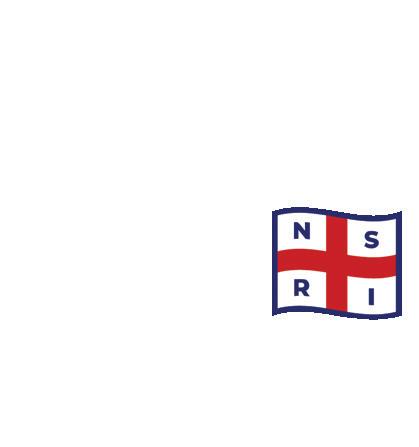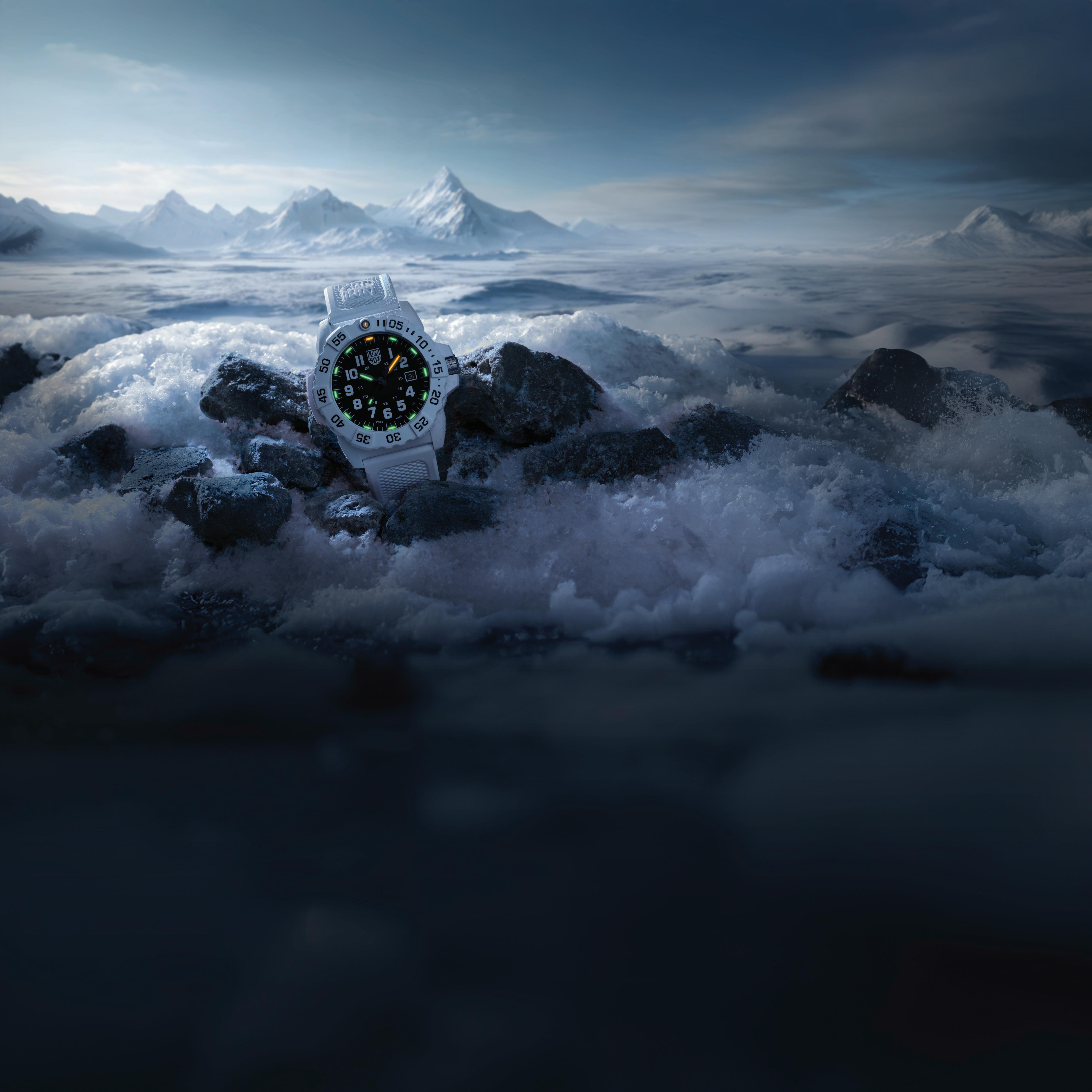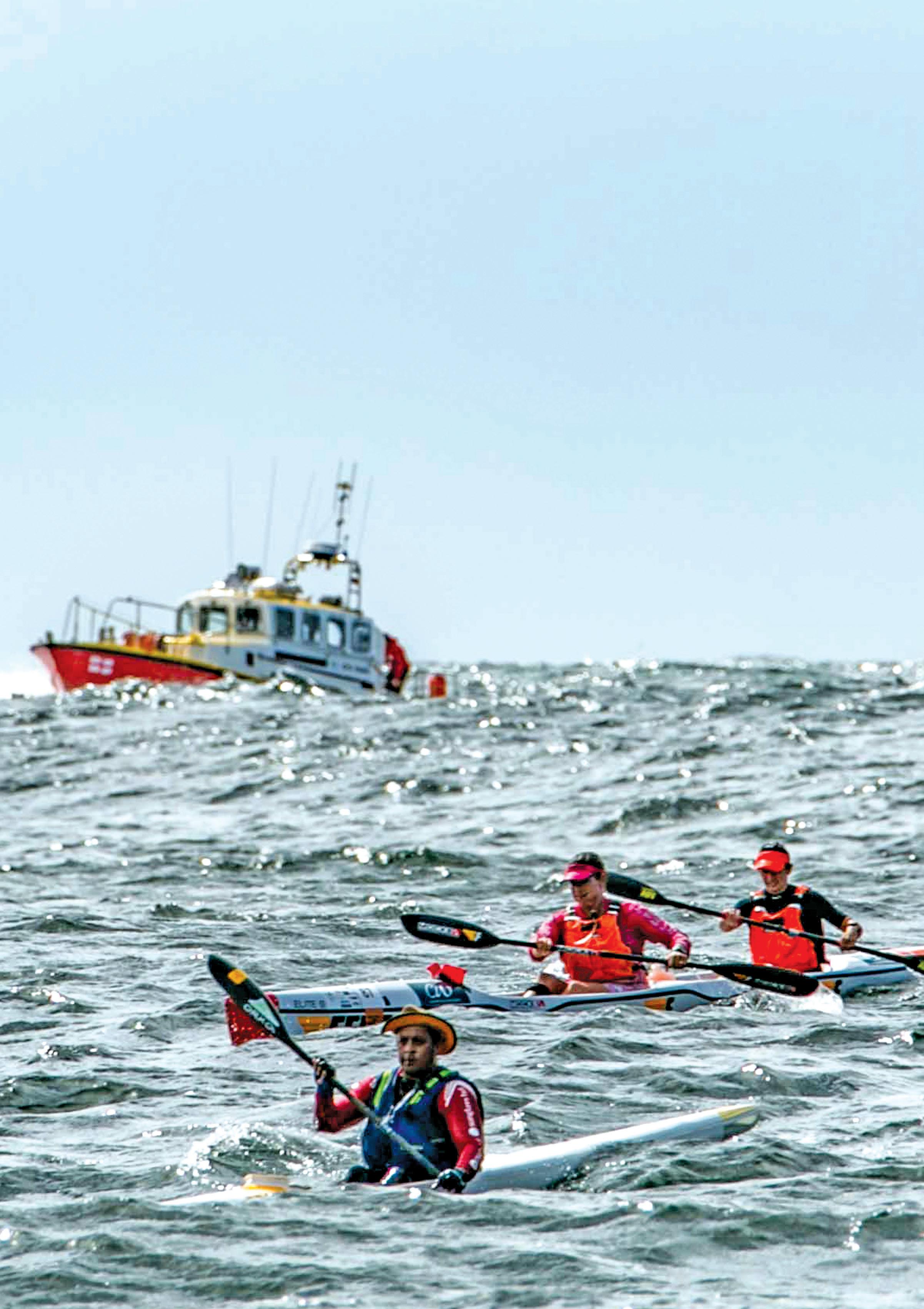
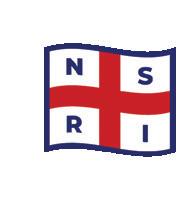
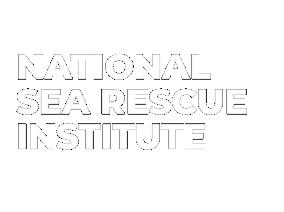
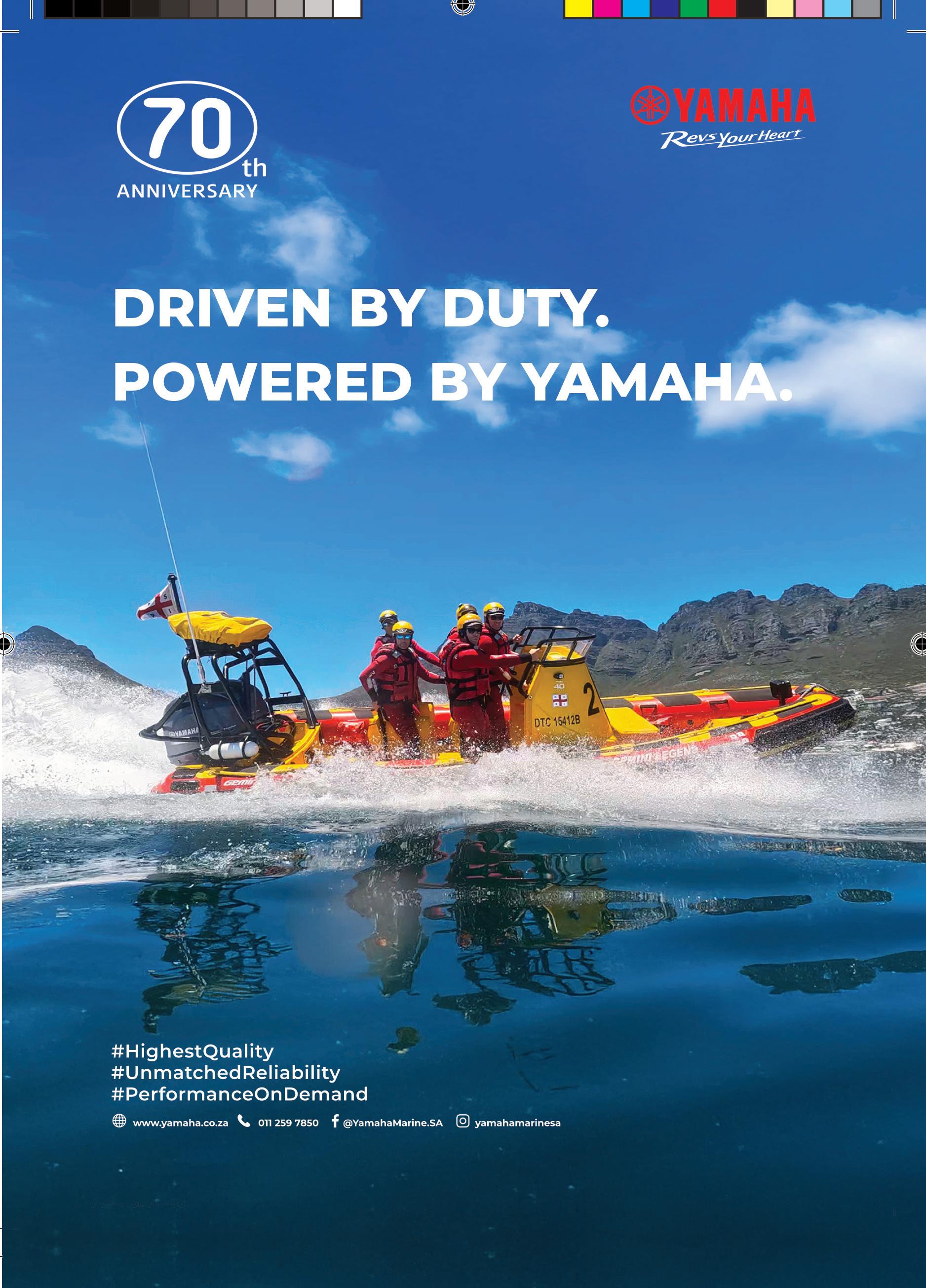
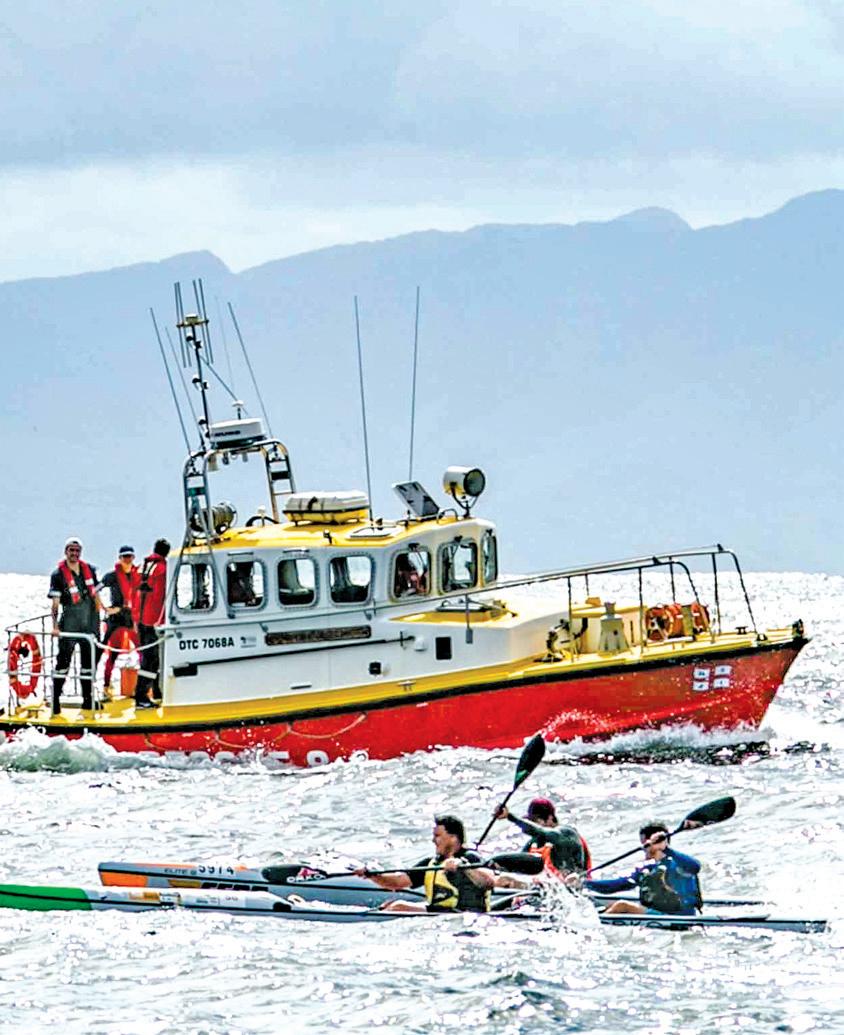
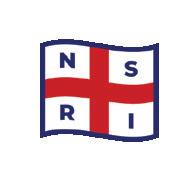
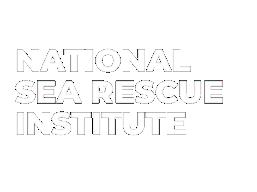
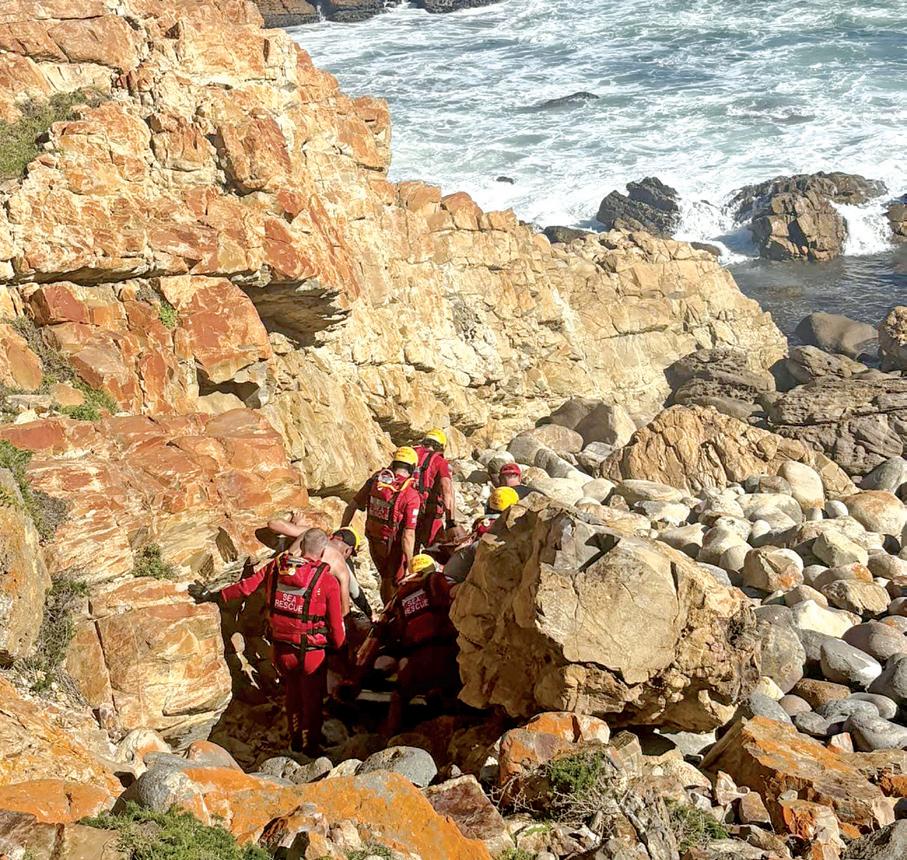
Four Water Safety educators share what they love most about their jobs.
NSRI Storms River and Oyster Bay share skills to execute tricky and tough callouts.
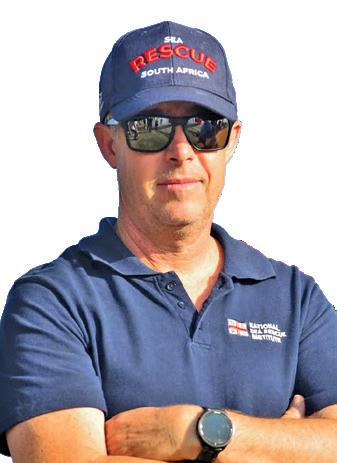









Four Water Safety educators share what they love most about their jobs.
NSRI Storms River and Oyster Bay share skills to execute tricky and tough callouts.

Over the past few months, we’ve had the privilege of hosting seven blessings of new NSRI boats and bases, stretching nearly 1 700km along our coastline: from Yzerfontein on the West Coast to Ballito in KwaZuluNatal, with Strandfontein, St Francis Bay and Gqeberha (Port Elizabeth) in between. Each of these junctures has made me appreciate the extent to which NSRI is rooted in the communities we serve.
What makes these events so moving is feeling the deep sense of shared purpose. As an organisation we connect with the community that supports us, and with the same community we serve. This mutual reliance is at the core of who we are. The NSRI is built on a simple truth: we exist for others, and we are made stronger by others.
These gatherings are a celebration of that spirit. They bring together volunteers in uniform, children aspiring to join the crew one day, retired rescuers who recall past operations and lives saved, and donors from all walks of life. Each donor arrives with a deeply personal reason: some to honour a loved one, others with a direct connection to the NSRI, and many simply to be part of something greater than themselves.
What all these individuals have in common is the spirit of ubuntu, the African
philosophy of ‘I am because we are.’ Ubuntu has its origins in the Zulu phrase Umuntu ngumuntu ngabantu, which literally means that a person is a person through other people. It speaks to the deep connection between people, and it reminds us that our strength, our compassion and our resilience grow when we act together
That same spirit shows up time and again in our donor community. One of my personal highlights each month is calling the winners of our Monthly Giving draws. In November last year, our R25 000 winner was a 19-year-old Stellenbosch University student. Our R150 000 winner in May this year was a 96-year-old woman in Gauteng. Different provinces, different generations, but united by a shared belief in the work we do.
When we bless a vessel, we’re not only preparing it for the sea and honouring time-old maritime traditions, we’re acknowledging the lives and hopes it carries. These boats represent the courage of our volunteers, but they also carry the trust of those who helped put them there.
To every donor, volunteer, family member, and community partner: thank you. You are not just part of our mission, you are the reason it matters.
With gratitude,
MIKE VONK CEO, NSRI
#ItsWhatWeDo
CAPE TOWN: NSRI, 4 Longclaw Drive, Milnerton, Cape Town, 7441; PO Box 154, Green Point 8051 Tel: +27 21 434 4011 Email: magazine@searescue.org.za Web: www.nsri.org.za facebook.com/SeaRescue youtube.com/@NSRISeaRescue @nsri @searescuesa @nsrisouthafrica
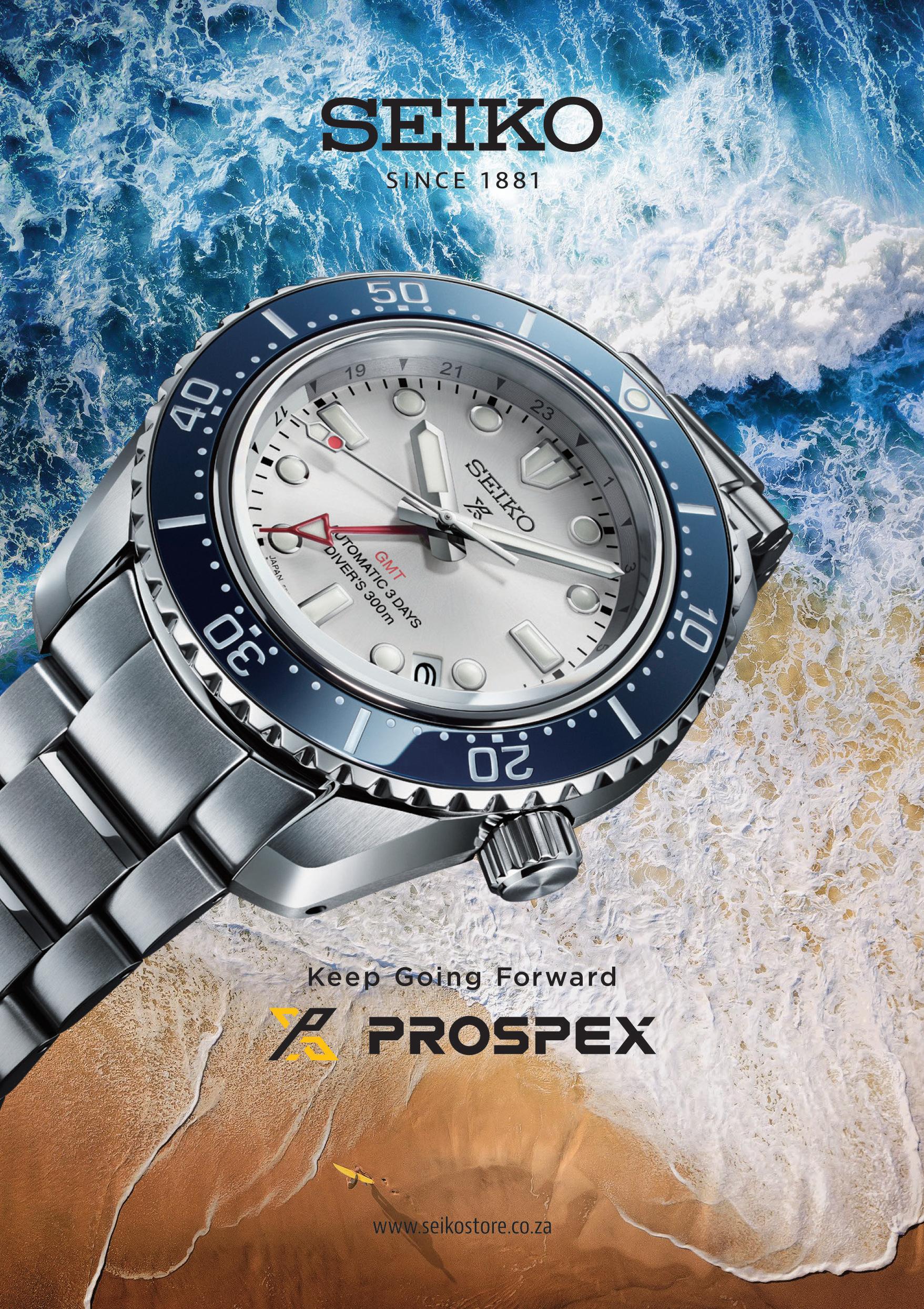
THE PUBLISHING PARTNERSHIP
MANAGING EDITOR
Wendy Maritz
ART DIRECTOR Ryan Manning
COPY EDITOR
Deborah Rudman
ADVERTISING EXECUTIVE
Bernice Blundell
MANAGING DIRECTOR
Susan Newham-Blake
PRODUCTION DIRECTOR
John Morkel
ADDRESS
PO Box 15054, Vlaeberg 8018
TEL +27 21 424 3517
FAX +27 21 424 3612
EMAIL wmaritz@tppsa.co.za
NSRI
OFFICE +27 21 434 4011
WEB www.nsri.org.za
FUNDRAISING AND MARKETING DIRECTOR
Janine van Stolk
janine@searescue.org.za
HEAD OF MARKETING
Bradley Seaton-Smith bradley@searescue.org.za
COMMUNICATIONS MANAGER
Andrew Ingram andrewi@searescue.org.za
PRODUCED FOR THE NSRI BY
The Publishing Partnership (Pty) Ltd, PO Box 15054, Vlaeberg 8018.
Copyright: The Publishing Partnership (Pty) Ltd 2025. All rights reserved. Reproduction in whole or in part is prohibited without the prior permission of the editor. Opinions expressed are those of the authors and not of the NSRI. Offers are available while stocks last.
PRINTING Novus
ISSN 1812-0644
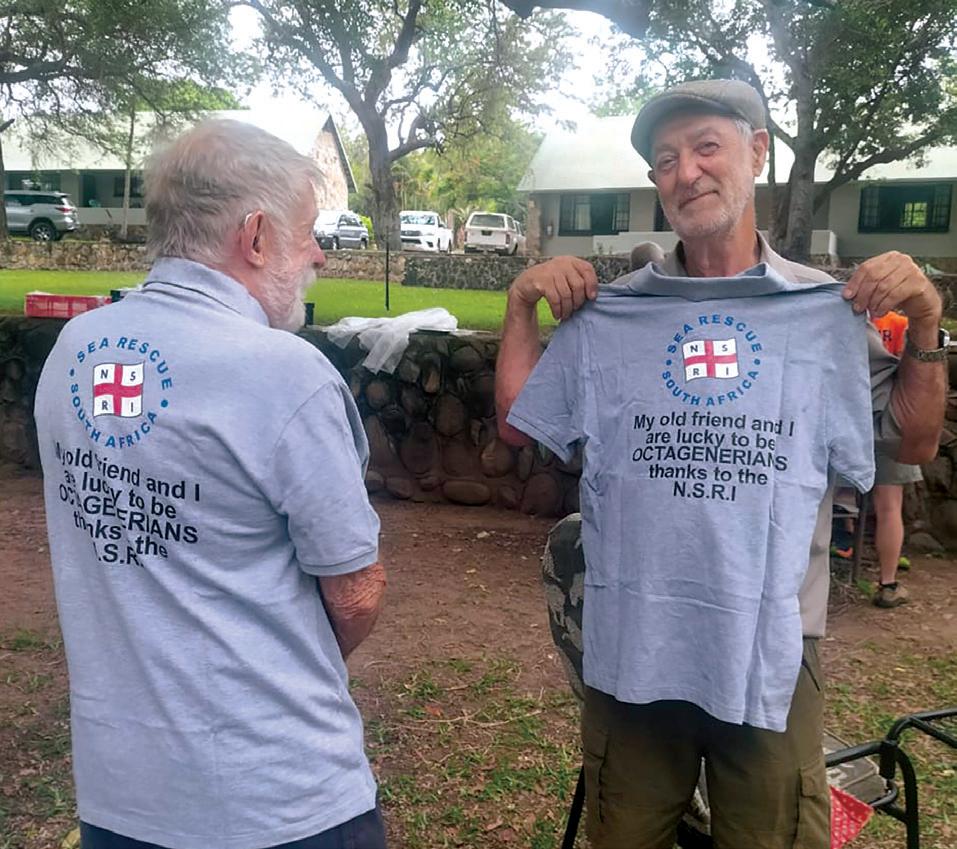
Congratulations, Laura, for submitting this memprable story. Your hoodie and book are on their way to you.
In December, my dad travelled from Port Alfred, Eastern Cape, to Hoedspruit, Limpopo, to share in his best friend Clive’s 80th birthday celebrations. My dad turned 80 in 2023.
What on earth to buy Clive – who is coincidentally my godfather – as a gift?
Wracking my brains I came up with these golf shirts that I had specially printed and then presented to both of them at the party. To say they LOVE these shirts and were absolutely tickled pink by the gift is an understatement. Several party guests suggested that I send in the story and the photo so here it is.
LAURA GUEST

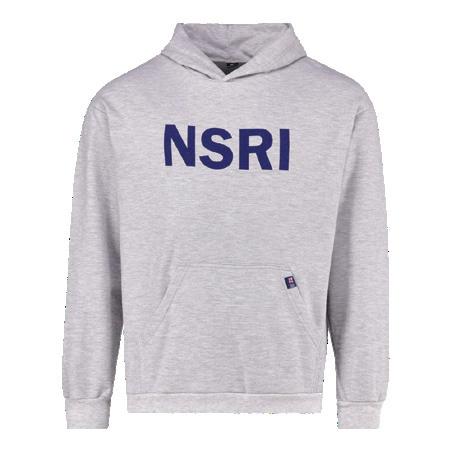
The writer of the winning letter published in the next issue of NSRI Magazine will win an NSRI hoodie Email us at magazine@ searescue.org.za with your stories.
THIS IS THE STORY OF CLIVE MENTIS AND GEORGE GUEST.
By George Guest
It wasn’t exactly holidaymaker weather, but it was perfect sailing weather on that fateful weekend in Plettenberg Bay, circa 1976.
Clive Mentis and I met while studying engineering at Technikon in Johannesburg and quickly became firm friends. We both sailed on Victoria Lake in Germiston. Clive, however, the owner of a Flying Dutchman, had more experience sailing on the sea.
On the first day, we launched the boat and made good time through the surf. The dolphins were alongside, and I was out on the trapeze. There was a strong breeze, and we had to work for it – pure exhilaration! We really enjoyed ourselves.
The next day, a strong offshore wind picked up. We readied the boat and pushed off. We sailed quite far out in a strong, steady breeze; it was fantastic.
Clive was on the tiller, I was on the trapeze, and we were loving every minute of it. We decided to sort a few things out and I went to the fore section. As I was attending to the ropes, I heard Clive shout, ‘Oh, the bloody rudder’s gone!’ followed by a splash. There he was, in the water, swimming towards the rudder.
He shouted, ‘Try get back to me!’
‘OK!’ I yelled back.
I had to get the sail down, and in the process, I broke a tooth trying to undo a shackle. By the time I got it done, I was too far away from Clive. There was a
paddle in the 20-foot boat, but there was no way I could paddle on my own, against the wind, in the open sea.
I could see Clive clinging onto the rudder, getting smaller and smaller as I drifted away. It was then that I realised there was nothing more I could do. I was out there, alone, and had no idea how long it would be before help arrived. In hindsight, I could have capsized the boat, but in the heat of the moment, it didn’t cross my mind. Instead, I used the spinnaker halyard to create a sea anchor, so I was facing into the wind and waves, but was still being blown out to sea.
I was out there for a long time, with nothing to do but think. I thought about my three kids, all under six, and wondered if I would ever see them again. I didn’t panic; I stayed quite philosophical, thinking through all sorts of scenarios. I wondered if I would wash up on the rocky Tsitsikamma coast and hoped that if that happened, I might somehow survive. I remember feeling cold. I thought about Clive, in the water, and about our wives and his two little boys.
Eventually, I saw a small wave approaching, and as it got closer, I saw a flash of orange. The NSRI boat pulled right up to me. As it came alongside, I saw a figure huddled in a blanket in the back – Clive.
‘Are you all right?’ the NSRI crew asked. When I said I was, they sent a man to swim across. Once aboard, he asked for details of what had happened. I explained the situation, and managed to get a tow rope attached to the rescue craft.
It was a long pull back to shore.
We were fortunate that the crew had
been at a christening when the alarm was raised. They had raced directly from the church service to our rescue. We later learned that the alarm was raised by a woman who had been sitting on her balcony, watching the sea, and realised we were in trouble. Another stroke of luck: this person had been alert and proactive!
Both Clive and I are still members of the NSRI to this day, and we hold the organisation and its volunteers in the highest regard. So when we received our NSRI 80th birthday shirts, it brought the whole mishap back to us – but in a good way. What happened to us was terrifying, yet neither of us ever held it against each other. It never ruined our friendship, and to this day, we salute the volunteers who make the NSRI the vital life-saving organisation that is a constant on our shores.
To NSRI in general and Oyster Bay in particular.
I thank you with all of my heart for the difficult rescue you undertook on my behalf on 4 April at the Elands River mouth.
I was too shocked and traumatised at the time to acknowledge any of you brave individuals or to thank you. Also, a special mention to the nameless dedicated person who held my head for two hours on the boat in difficult circumstances. You may well have saved me from paralysis.
I feel grateful for this amazing service you voluntarily choose
(often putting your own lives in jeopardy on behalf of someone else).
I am also glad I donated to the NSRI earlier this year, although I still feel enormously indebted to you.
I spent two weeks in hospital and am currently immobilised at home with a broken neck, from which, thanks to my son-in-law and son, who rescued me out of the sea, and all the EMTs who came down to stabilise me and finally the NSRI team, I will gradually recover.
DEA WILSON
The Morgan Bay lifeguards are amazing! Always alert and watching and even picking up the litter. They deserve a bonus!
SEONA COCHRAN
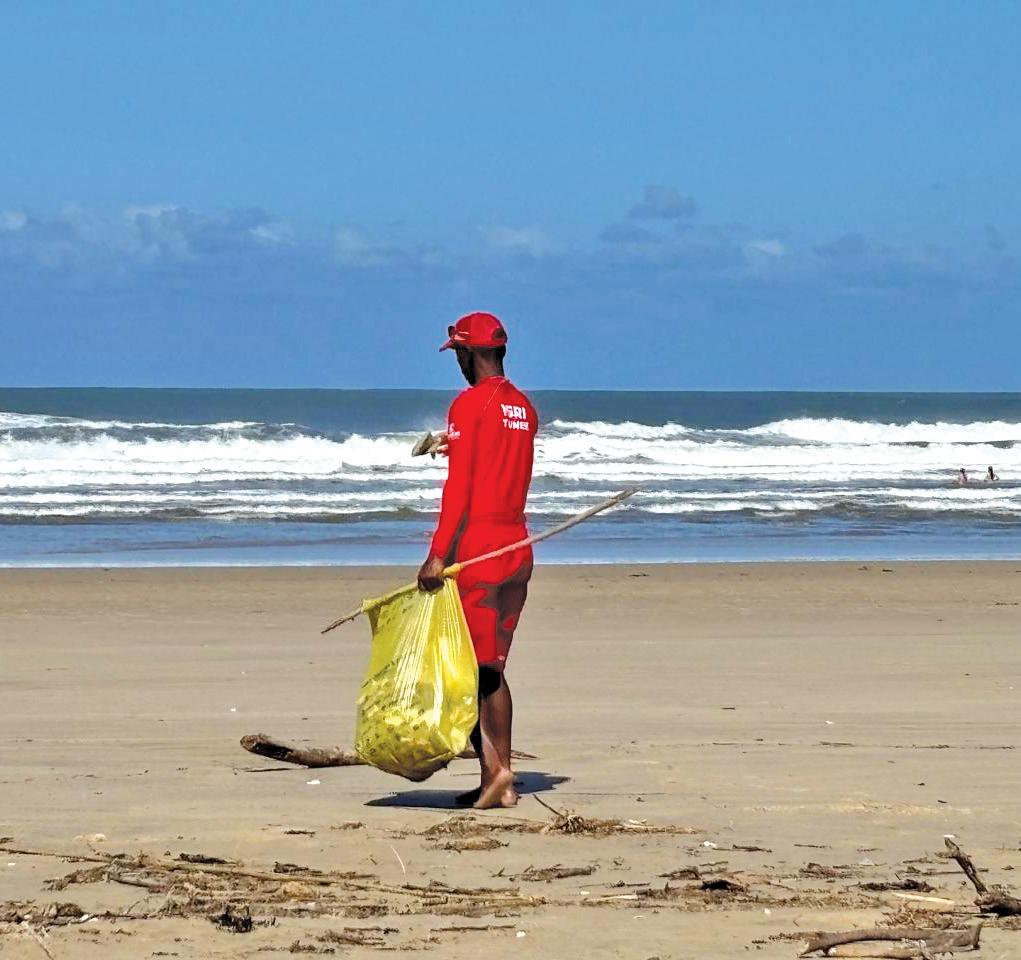
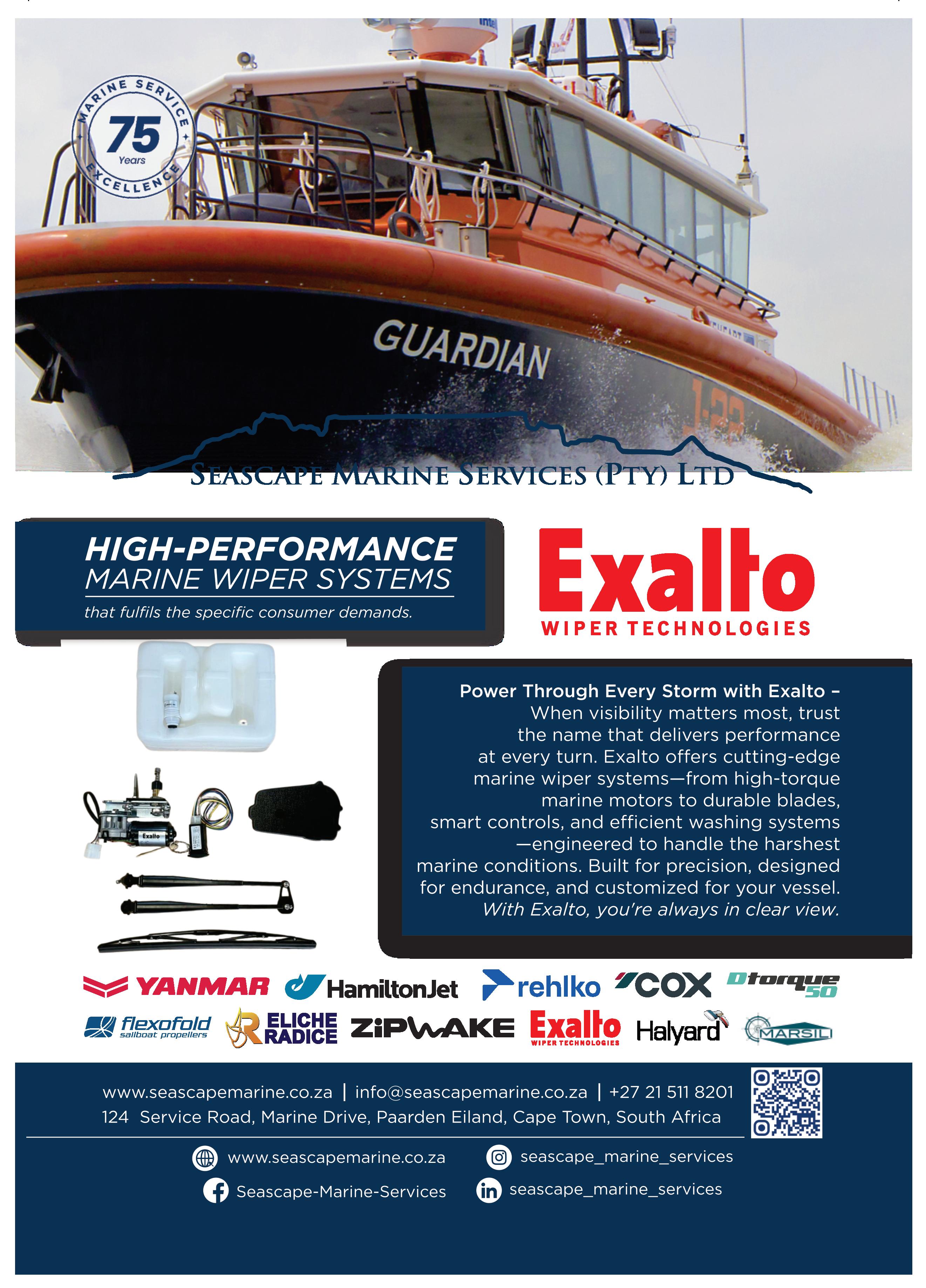
Viewed from any angle the ORC is an impressive vessel. Spanning 14.8m in length and 4.8m in width, it’s significantly bigger than Sea Rescue’s previous Class 1 fleet of Breedes. The NSRI ORC project, which started with the first build in France in 2016, and then moved to Cape Town from the second vessel, is now nearing completion. Hull 7 is out of the mold and hull 8 is in. This is the last ORC being built in the current phase of production. (The mold will be kept for possible builds in the future.) Station 4 Mykonos is well into their base rebuild and Station 8 Hout Bay is preparing to
transition to their temporary base. They’re counting down the days until demolition of the old base, which has been located in Hout Bay harbour since 1979.
We caught up with recently appointed Head of Fleet and Facilities at NSRI Graeme Harding, who is overseeing both base and boat builds. The reason that most Class 1 stations have had to be rebuilt is due to the sheer size of the vessels. Also, many of the bases were more than 30 years old. Ageing infrastructure needed to be upgraded in order to support volunteer crew and provide them with the resources essential for conducting successful rescues.

This year marks an exciting phase for NSRI’s large boat replacement programme. By the end of 2025, eight offshore rescue craft (ORCs) will have been built, bringing the first and most ambitious part of the programme to a conclusion. By Cherelle Leong

For example, in decades past, female volunteers were usually only shore controllers. There were no female changerooms or toilet facilities, they simply had to share with the men. Today, bases like Hout Bay boast a more than 30% female crew complement, including Class 1 and 3 coxswains. The new base design reflects this, providing ample changeroom and bathroom facilities for female crew.
This is not the only design modification made to Station 8’s base, but fortunately Hout Bay has had a great deal of time to work through these. Twelve years in fact. The station was originally designated to receive hull 3. But complexities and delays in planning permissions for the base put all building on hold and subsequently Hout Bay went to the back of the ORC waiting list.
At the time, with their new base building already completed, Hermanus (Station 17) received hull 3. Hull 4 went to Table Bay
Hull 7, earmarked for NSRI Mykonos, out of its mold at Two Oceans Marine.
(Station 3), hull 6 to Gqeberha (Station 6), and hull 5 to Richards Bay (Station 19), which involved an epic delivery up the coast from Cape Town. Graeme recalls how that voyage cemented his belief that the ORC was exactly what the NSRI needed in a Class 1 deep-sea rescue vessel.
On the last leg of the trip from Durban up to Richard’s Bay, they encountered heavy seas. Despite this, St Lucia crew had travelled south to welcome the new vessel into Richards Bay. Aboard their 7.3m RIB it hadn’t been as comfortable a ride. Three of the crew were horribly sea sick and fatigued by the time they got to Richards Bay, leaving only the coxswain and her fellow crew-woman available to return the 7.3m RIB 42 nautical miles up the coast. Graeme and Dean Wegerle, who had been part of the ORC delivery crew,
didn’t hesitate to don wetsuits and join the St Lucia crew on their voyage back to their base. This was only possible because the ORC had handled the rough seas so well that they weren’t exhausted.
This was something that Graeme had experienced on the very first ORC delivery to Station 5 Durban. They’d left East London for the leg to Durban at 3am. It was a clear and calm morning, with relatively flat seas. There was the temptation to open the throttles and see what the vessel could do. The problem was that the distance of
Both
the ORC and the 7.3m RIB will be housed on cradles running on rails with a central winch operator control box. This will enable faster, easier launching of both vessels.
the leg already set them close to the fuel limit for the journey. Also, that stretch of coastline is notorious for rapidly changing weather conditions which result in standing waves. Erring on the side of caution the delivery crew stuck to their 20-knot maximum speed. Good thing too, as a few hours into their journey a storm front blew in, creating choppy seas and lengthening their journey time. They made it into Durban with only 60 litres of fuel remaining in each tank. The crew were a little weary from the long day, but not feeling at all battered even though they’d encountered heavy seas, all due to the ORC’s excellent handling of the rough conditions.
It’s this focus on crew safety and wellbeing that has resulted in small changes in each of the ORCs and bases as they’ve been built. Richards Bay operates in a hot subtropical climate and this required increasing the size of the air conditioners in the cabin of their ORC.
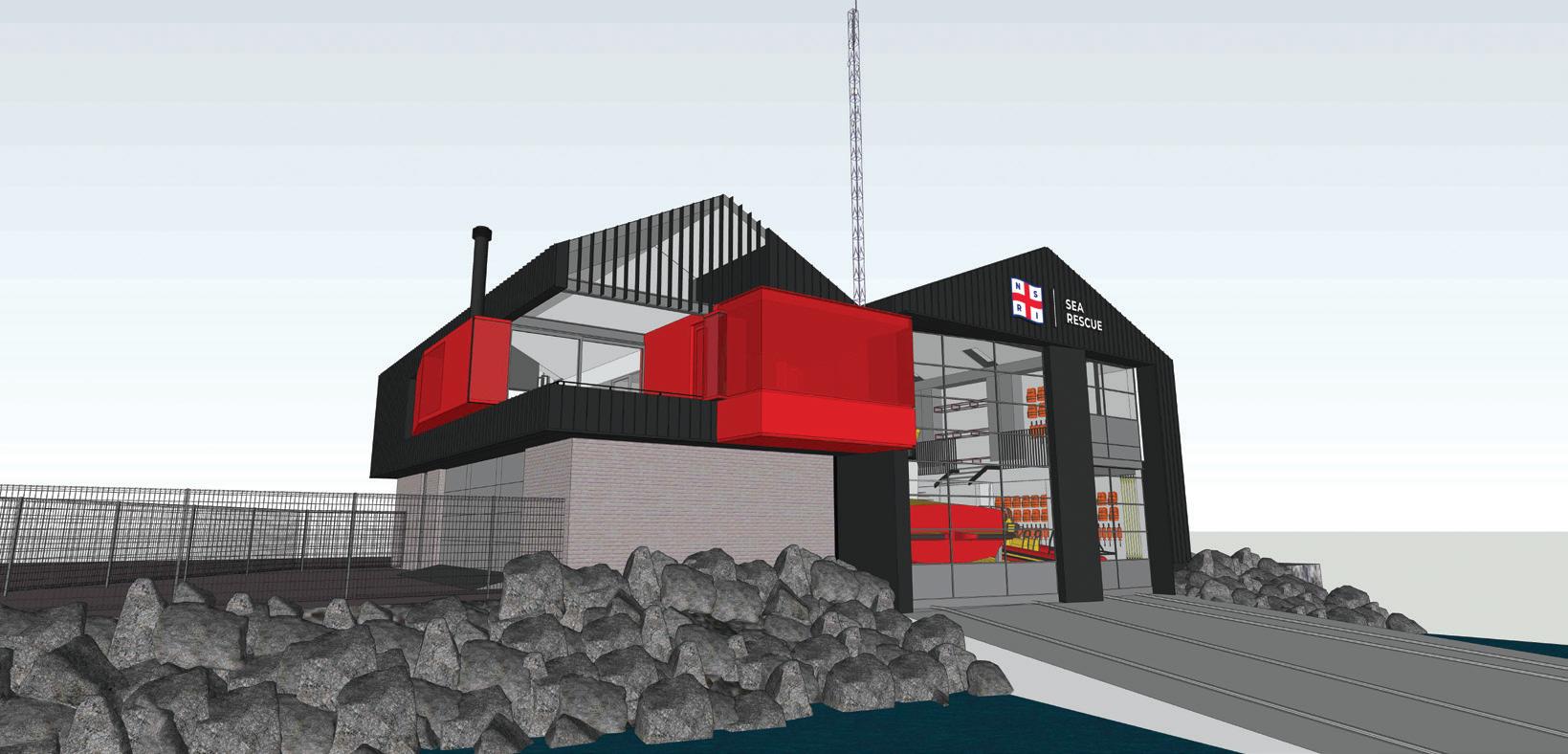
An architect’s rendition of what Hout Bay (Station 8) will look like once completed.
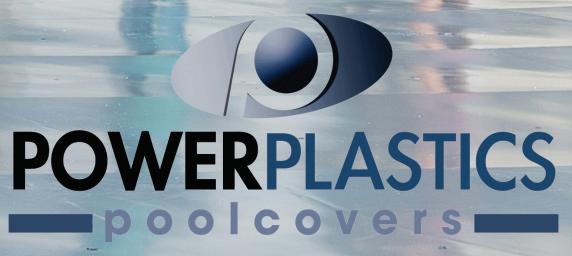



At Hout Bay, critical consideration was given to how to design the base to make it fit for purpose. In the past, the base has been used as a JOC (Joint Operations Centre) where major rescues and operations have seen multiple rescue organisations come together and join resources. From wildfires and floods to multi-day searches and mass casualty events, Station 8 has seen them all in the past two decades. Rebuilding the base has been the ideal opportunity to adapt the design to its specific needs.
In Station 8’s design, the upstairs crew and operations area has been divided up with sliding doors so that access to the ops room and boardroom can be closed off to be used as a JOC when needed. The downstairs workshop and parking garage for the mobile vehicle doubles up as an area that can be used for triage and medical treatment of casualties if needed. The crew changerooms and bathrooms were moved upstairs and the access ramp to the ORC moved to starboard so that crew have quick and direct access without having to climb up or down stairs. Both the ORC and the 7.3m RIB will be housed on cradles running on rails with a central winch operator control box. This will enable faster, easier launching of both vessels.
At Mykonos there were physical constraints leading to changes in the design. Space constraints on land meant that the slipway had to extend further into the water. The movement of tides also complicated construction as slabs had to be cast in the water. This required a change in con-
NSRI Mykonos is undergoing major reconstruction to accommodate their new ORC, which will be delivered at the end of 2025.
crete mix and set the project schedule back by two weeks. However, on land, construction of the base has proceeded apace and the contractors are confident they’ll be able to catch up. Completion is earmarked for November 2025, just in time to receive the ORC, which is scheduled to have completed its sea trials by then.
The Hout Bay base and ORC build will continue throughout 2025 and are scheduled for completion by April 2026. In the meantime, crew and coxswains will be getting up to speed on the ORC’s navigation system, engines and capabilities, honing their abilities to operate as helmsman, navigator, bosun or engineer.
As the ORC building project comes to a close, a new era in rescue starts. The ORCs will enable rescue crews to go further, respond faster, and still support crew resilience in the process. While the volunteers may change over the next 40 years, the newly built bases and ORCs will remain the backbone for Class 1 station rescue operations. A large but worthwhile investment in the future of Sea Rescue, helping us continue to effectively save lives at sea in South Africa.

Surf-skiing, kayaking and SUP-ing continue to be popular water sports all year round. But things can go wrong in an instant on the open water. Cherelle Leong reviews a few recent rescues and reminds us of key safety protocols.
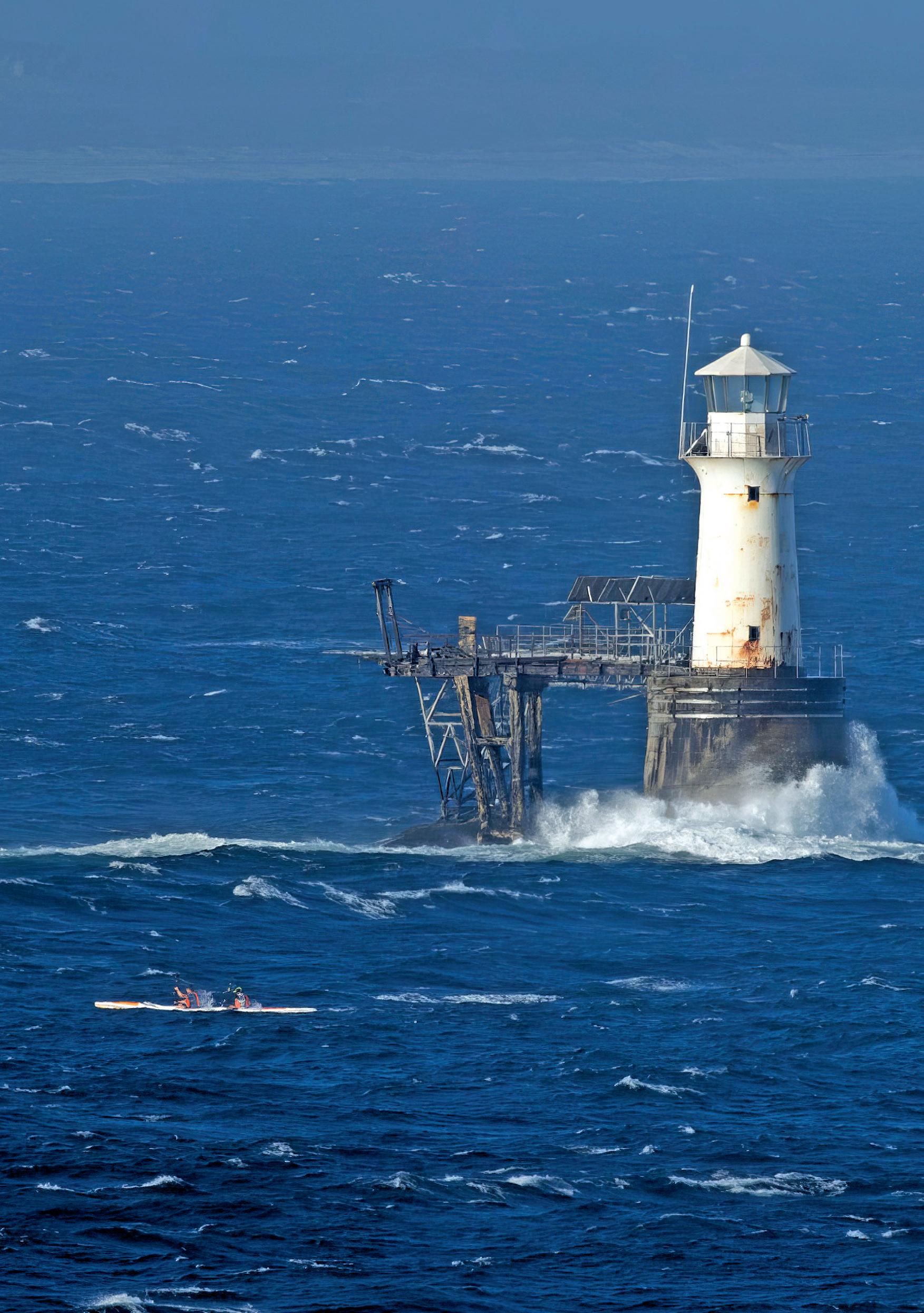
There’s nothing quite like being out on the water in the late afternoon, paddles slicing through the water, kayak cresting the swell, and feeling the occasional sea spray on your face. Surf-skiing is a popular sport in South Africa as is recreational paddling and SUP-ing. Tour operators all along South Africa’s coastline offer paddling sightseeing tours. There are opportunities to see dolphins in Hout Bay, whales in False Bay or Hermanus, and experience the ocean in a unique way.
Yet, as with any water sport, there are risks, especially with our temperamental coastline. What starts out as a calm day can quickly turn gusty with swells and waves forming a foamy obstacle course to navigate through. Even the most experienced paddlers can find themselves in difficulty, capsizing and being too tired to pull themselves back on board. Fatigue quickly turns to hypothermia, especially in the cold Cape waters, and it can be fatal.
That’s the knowledge Sea Rescue crew and coxswains bear when they get a callout for a paddler in difficulty. Every minute counts, every decision influences the outcome, especially as it could be a life hanging in the balance.
Experienced paddlers generally know the drill and the risks. They typically have the right safety equipment, are fit, know the area they are paddling in, activate SafeTrax, and still sometimes find themselves in difficulty. That SafeTrax alert makes all the difference. In a stormy sea, even with just a metre or two of swell, it can be very hard to spot a white surf-ski in the waves. Even on calm days, it can be tricky. It’s one of the reasons paddlers are encouraged to wear bright clothing when heading out to sea.
In 2024, when Louis Eksteen found himself in difficulty while paddling in False Bay, he simply pressed the call for help button on his SafeTrax app. Within minutes he was speaking to NSRI’s Emergency Operations Centre (EOC), which relayed his emergency to the closest NSRI station – Simon’s Town. As the Simon’s Town crew prepared to launch, Coxswain Andrew de Kock was given a tablet with the SafeTrax co-ordi-
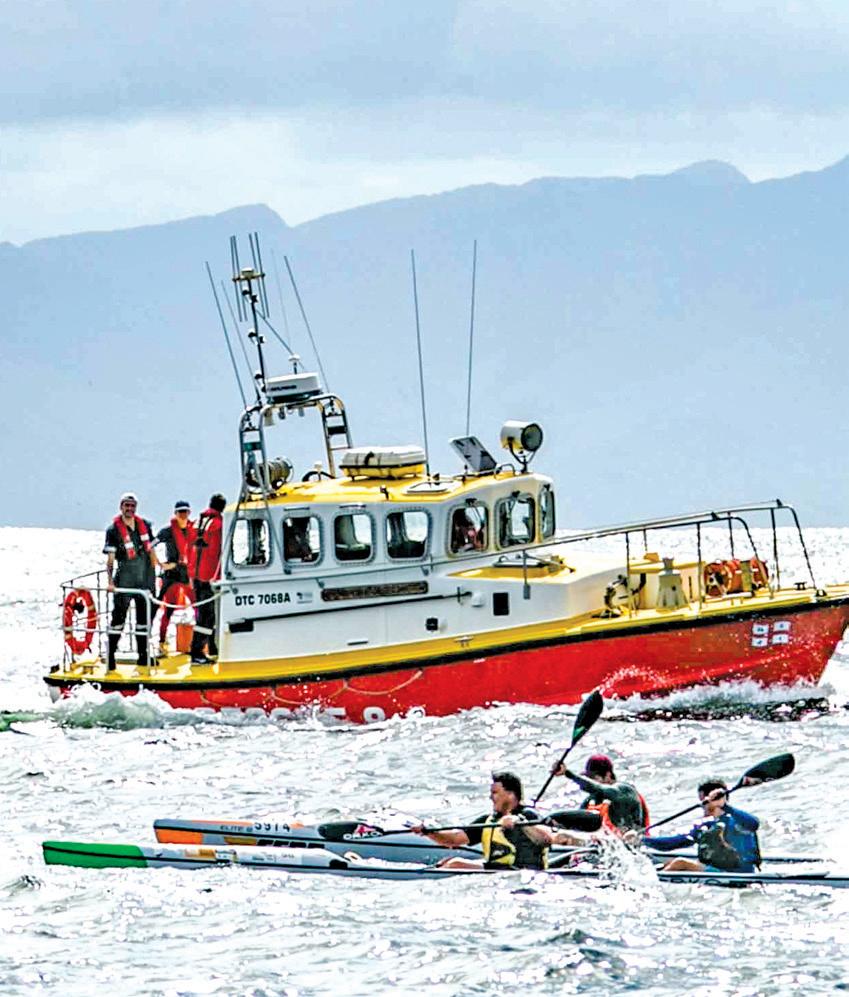
Even the most experienced paddlers can find themselves in difficulty, capsizing and being too tired to pull themselves back on board.
Fatigue quickly turns to hypothermia, especially in the cold Cape waters, and it can be fatal.
nates of where Louis was. This wouldn’t be a protracted search. GPS coordinates were plugged into the navigation system which led the crew straight to his position. A rescue swimmer entered the water to hold onto Louis’s kayak while he climbed on board the rescue vessel. Once the
kayak was secured on the aft deck, they headed back to Simon’s Town base. A little cold, but not too worse for wear, Louis was grateful for the lifeline that connected him to the NSRI when he needed it.
But sometimes it’s eyewitnesses who spot a paddler in distress. With those calls, the NSRI doesn’t have coordinates to steer towards, only a line of sight and eyewitness descriptions. Earlier this year, Station 8 Hout Bay got a call from former Station Commander Geoff Stevens, who was visiting his mother-in-law. He’d seen a stand-up paddler in the bay, not making progress for a while, appearing to be fatigued and waving for help. He called in his concerns and Station 8 launched their JetRIB Spirit of Gabi to assist. When they reached the paddler, she was indeed cold and fatigued, and very grateful for rescue. She’d hired a SUP from the local
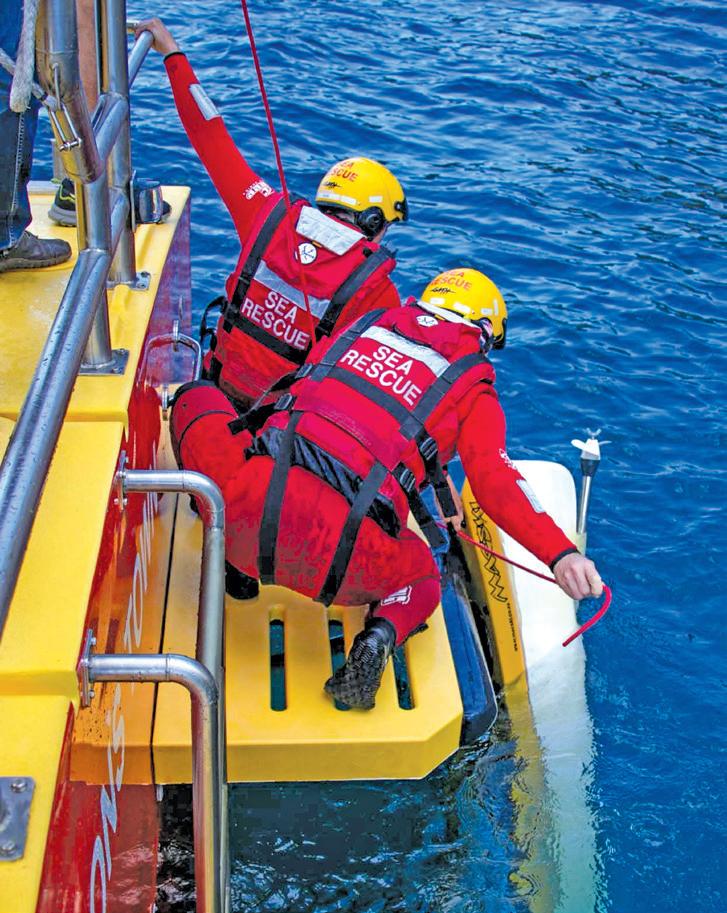
gym, but underestimating the effort it took to paddle and unfamiliar with the risk of offshore winds, had found herself in difficulty. The rescue crew were able to deliver her safely back to Hout Bay beach where she required no further assistance.
In April 2025, Station 12 Knysna were also activated based on reports of a kayaker in difficulty in the Knysna Heads. Anyone familiar with the Heads knows how treacherous the area can be, with swirling currents and breaking waves battering the towering cliffs. It’s certainly not a place to hang around. Station 12 launched rescue vessel JayTee IV and deployed shore crew to keep a lookout and monitor the kayaker. It was a rescue that would require perfect timing: deploying a rescue swimmer into the water to hold the kayak while assisting the kayaker to get on board; then quickly recovering the kayak and rescue swimmer before navigating a set of breaking waves and heading further out to sea. It was there that the rescue crew waited for a lull in the waves to re-enter the Heads and return to the rescue base.
These rescues highlight the importance of understanding your ability when setting out on a paddling excursion. It can be a fun leisure activity, but any change in the weather or wind direction can mean trouble. Paddlers, both recreational and more professional, should familiarise themselves with the area, paddle with a life jacket and fully charged phone with SafeTrax activated. The ocean is beautiful but unpredictable. Always be prepared.
Simon’s Town NSRI assisted a paddler whose vessel had sunk. The casualty had managed to get himself to safety onto nearby rocks.
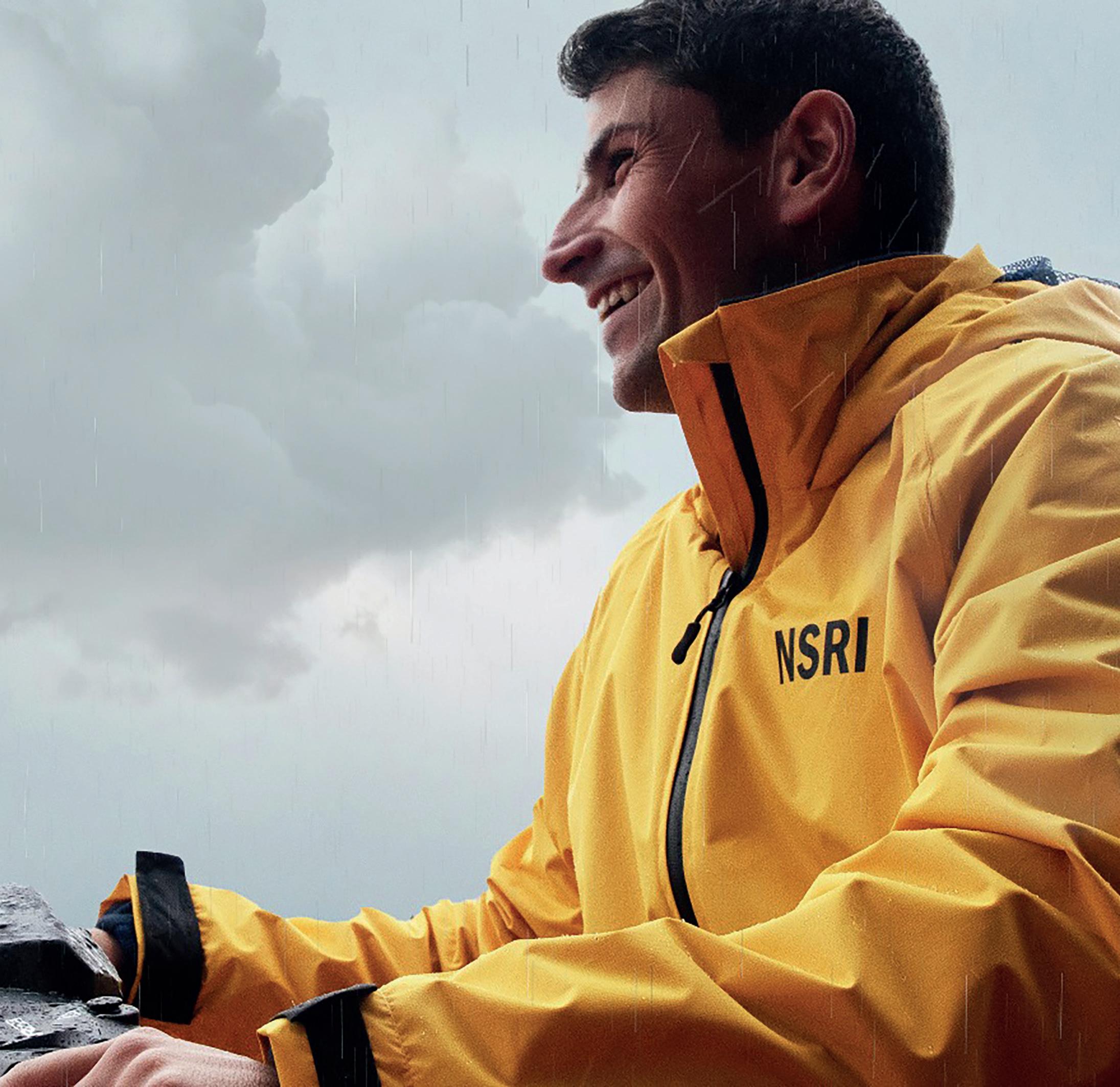


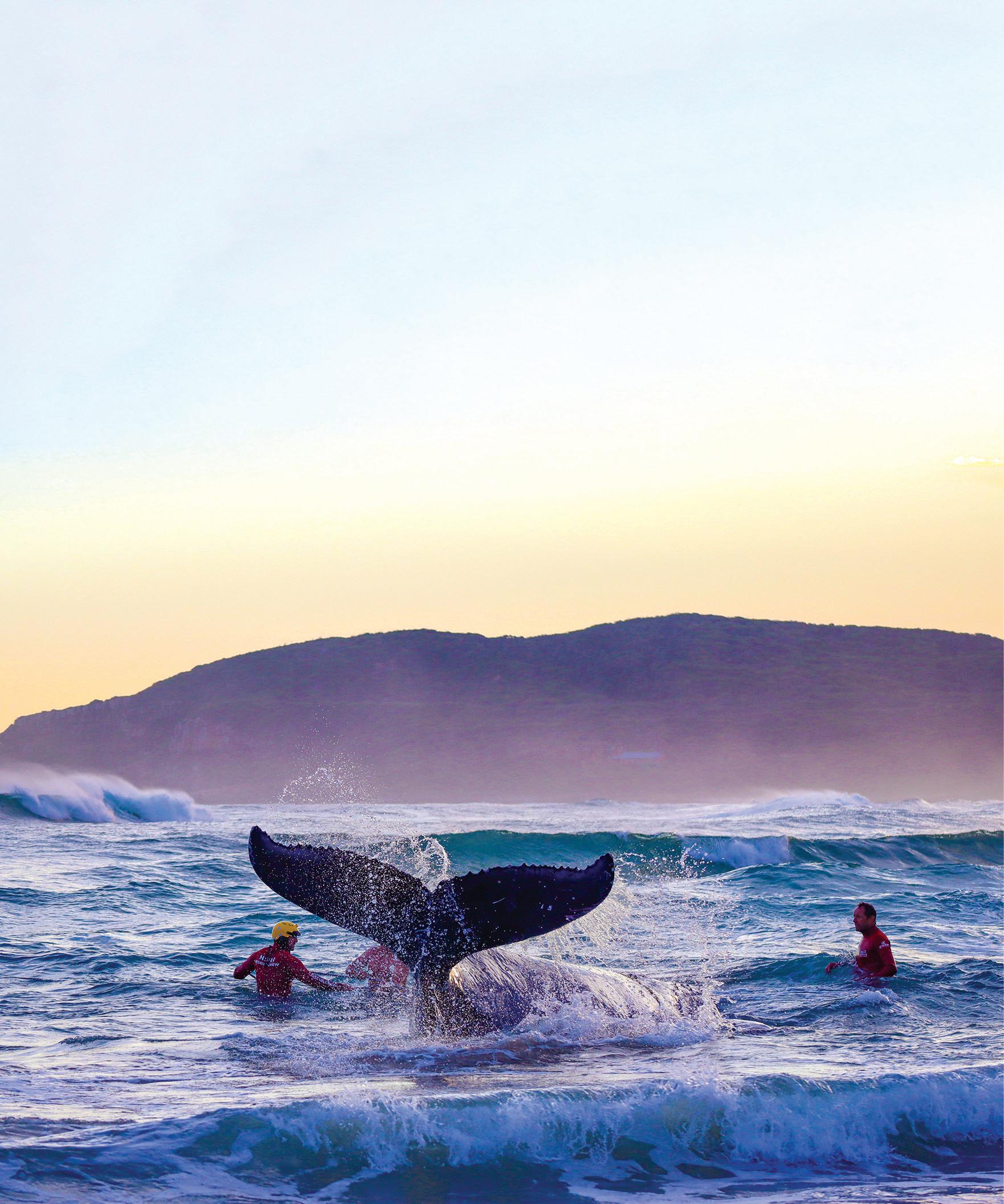
A recent attempt to assist a stranded juvenile humpback whale off Robberg Nature Reserve’s Island Beach in Plettenberg Bay illustrates the commitment of NSRI volunteers and conservation experts to help animals in distress. We spoke to Plettenberg Bay Station Commander Jaco Kruger about how the day unfolded. By Wendy Maritz
Whale, dolphin and whale-shark strandings are infrequent but not uncommon along Plettenberg Bay’s coastline. When they do occur, the NSRI is usually included in the list of responders because they have the equipment and expertise to assist from land and sea. NSRI Plettenberg Bay is one of the stations where crew have received training in whale disentanglements, work that no doubt has given them incredible insight into just how powerful – and yet also
vulnerable – these mighty creatures are. Which begs the question: How do you get a stranded six-ton marine mammal back to its natural habitat safely?
‘It’s an important question to ask and conversation to have,’ says NSRI Plettenberg Bay Station Commander Jaco Kruger, who’s been involved in several whale disentanglements and strandings as the station works closely with the research and conservation networks that coordinate such callouts. ‘There are very specific protocols set out under national legislation that must be followed when whales or dolphins beach. You can’t just go out there all gung-ho and say, “we’re going to save this whale”.’

Plettenberg Bay crew and marine-life authorities attempted to refloat the whale twice and both times it rebeached itself.
Jaco received a call from Henk Nieuwoudt, Conservation Manager for Cape Nature, on 19 May, informing him of a live stranded whale on Robberg Nature Reserve’s Island Beach. ‘He sent me a video, and I could see it was a juvenile humpback whale. There were no obvious signs of injury, and its body appeared to be in a healthy condition, so it hadn’t been starving.’ Jaco goes on to explain that juvenile humpbacks are usually weaned within a year of birth, after which they are less dependent on their mothers for milk, although they do maintain social bonds for several years until they reach maturity.
Jaco points out that the whale was stuck on a sandbank, placing it directly in the surf zone, which can be ‘very noisy and disorientating’, especially considering these marine mammals’ sensitivity to sound for communication and navigation. This is
another reason why it’s important to follow protocols and take guidance from scientists on how to minimise further stress to the animal. Local marine-mammal scientist Dr Gwen Penry and Cape Nature’s senior marine ranger, Chanel Visser, who are both permitted stranding responders under the Marine Living Resources Act, were also contacted. Jaco emphasises that ‘lots of boxes need to be ticked before we get involved. Before any decisions are made on the best and safest course of action for the animal and the responders, we need to consult the Department of Forestry, Fisheries and the Environment (DFFE), Bayworld at the Port Elizabeth Museum, and the local organisation with jurisdiction, which in this case was CapeNature, but may be SANParks or a local municipality if an animal strands outside of a protected area.’
This is because marine mammals are protected species under the TOPS (threatened or protected species) regulations.
The station launched its largest vessel, the 7.8m Courtenay’s Rescuer, because it can accommodate nine crew (‘We were going to need all the manpower we could muster’), the JetRIB Eric Stratford and then later, Farnham Rescuer joined with additional crew.
Because the crew had been involved in previous strandings, they took extra straps, webbing and tie ropes with them. ‘We weren’t going to be able to push the whale off the sandbank. You’re dealing with an animal several times heavier than an elephant,’ says Jaco. ‘So the idea was to secure it with a strap attached to the rescue boat and then try pull it off the sandbank using the rising tide as an aid. You have to be very careful when securing the straps to a whale. You can’t, for example, put them around its tail fin – you can cause injury or break its back. Fortunately, we were able to secure the straps around its body behind the pectoral fins (flippers). We timed the pull with the movement of the sea, and managed to get it off the sandbank and into deeper water, but it kicked back, and we had to let go because we can’t fight with a six-ton whale. We managed to refloat it twice, but unfortunately it rebeached itself twice,’ Jaco explains.
to euthanise the whale. Rather that, than have it perish slowly on the beach, which can take several days.
‘But because it’s a water-based callout, we returned the following day with rescue swimmers to assist the police with the euthanasia.’
Because the crew had been involved in previous strandings, they took extra straps, webbing and tie ropes with them.
This stranding was difficult and emotional, Jaco admits. And there are always bystanders who want to help. Part of managing a scene like this is protecting members of the public or even authorities as one is dealing with a large animal with a large and very powerful tail fin and, for the most part, the rescue is in the water. And what if the whale moves or shifts and someone is trapped under it? ‘We must pro tect the people as well as the animal. But we did appreciate the public concern and all the efforts from bystanders,’ Jaco adds. ‘We really hoped for a better outcome; unfortunately, it was not to be this time.’
The crew had been busy for four-and-ahalf hours. It was getting dark, and they had to abandon their efforts for the day. ‘We offered to go back the next day to try again,’ Jaco says, ‘but the authorities made a decision early the next morning
Jaco does feel that the experience was valuable in terms of crew learning, rein forcing protocols, and the importance of collaboration with marine-life authorities, the stranding networks, government, po lice as well as members of the public. ‘The success of an operation depends on plan ning, having adequate equipment and per sonnel, understanding the risks involved and respecting the chain of command.
‘Personally, it was a privilege for me to take part in this callout, to try to be a part of the best solution for this stranded animal,’ Jaco says.


One donation enters you into all the draws, where you could win not just one, but up to four Mitsubishi Outlanders – plus, you’ll be helping us save lives every day. Do good, feel good – get your ticket today!



Terms and conditions apply.
Plettenberg Bay NSRI crew were called to assist a hiker in serious trouble in Robberg. Clair Broodryk shares her harrowing story with Andrew Ingram.

On the second morning of their holiday in Plettenberg Bay, Johannesburg couple Clair Broodryk and Andrew Nye set out to hike the iconic Robberg Peninsula trail. It was Monday, 28 April. The weather was spectacular, but already heating up as they left their guesthouse around 8.30 am.
‘We had water with us,’ Andrew recalls, ‘but probably not enough. As we got further, the heat started to build. When we reached the point where the trail splits, we decided to take the longer route.’
For Clair, the hike quickly turned from a holiday highlight into a lifethreatening ordeal.
For Clair, the hike quickly turned from a holiday highlight into a life-threatening ordeal.
‘I was still feeling okay at the halfway mark,’ she explains, ‘but at the point of Robberg, I became really tired. Andrew says I started saying strange things, and I remember that all I wanted to do was sit down.’
Moments later, Clair collapsed.
‘She was completely out of it,’ Andrew says. ‘I couldn’t wake her. My phone battery was dead, and I didn’t know the code to unlock hers.’
It was at that critical moment when another hiking group rounded the bend. Jaco Delport and his party, which included
NSRI crew carry Clair Broodryk down from the area of Robberg where she collapsed. Members of another hiking group, a doctor among them, assisted until they arrived.
a local doctor from George, immediately recognised the seriousness of the situation.
‘We saw her boyfriend trying to keep her from rolling down the path,’ Delport explains. ‘Her arms were flailing even though she was unconscious. It was serious.’
The doctor quickly assessed Clair and called for urgent help. ‘We knew we had to bring her body temperature down,’ Delport says. ‘So we ran to the ocean, filled every bottle we had with cold seawater, and poured it over her.’

Clair is stabilised before being carried down to shore from where she was transported to Central Beach and further medical care.
The group made countless runs, around 20 to 30 trips back and forth to the sea. ‘By the time we came back up, she was already dry and hot again,’ says Delport. ‘So we soaked clothing and draped it over her to hold in the moisture.’
Meanwhile, NSRI Plettenberg Bay Station Commander Jaco Kruger had just received two back-to-back distress calls: one for an elderly hiker near The Gap, and the second for an unresponsive woman on the far side of Robberg.
‘Even with six people carrying her, we had to pass the stretcher down from person to person.’
‘We handed the first case to the park rangers,’ Kruger says, ‘and launched our rescue boats, Courtney’s Rescuer, a 7.8m RIB, and the JetRIB Eric Stratford, along with our floating stretcher and medical equipment.’
Conditions were challenging. ‘That part of the mountain is one of the most difficult places to reach,’ Kruger explains. ‘And the AMS helicopter was not available. We had to swim ashore through the surf and climb the rocks with all our gear.’
Two NSRI crew members were the first to make contact with the doctor and the hikers on the scene. ‘They immediately acknowledged the doctor,’ Delport recalls. ‘They didn’t override him; they worked with him, asked him to stay, and kept checking in. It was very professional.’
More rescuers followed, swimming through the heavy surf with the floating stretcher, which was designed in Plettenberg Bay and perfected over
the years through extensive training. ‘That stretcher was instrumental,’ says Delport. ‘It has a hard fibreglass base like a small boat, and it made this rescue possible.’
But getting Clair down the steep terrain was another ordeal.
‘Even with six people carrying her, we had to pass the stretcher down from person to person,’ Kruger explains. ‘We were bending under the strain, but there was no other way.’
On the way down the mountain, NSRI crew member Jarryd du Preez suffered a severe cut to his hand.
‘Even with his injury, Jarryd helped to complete the rescue and then still played a crucial role in helping the final two casualties off the mountain,’ says Kruger.
‘Only once the last people were safely evacuated was he recovered and taken for stitches,’ he adds.
When the stretcher team brought Clair to the water’s edge, the JetRIB Eric Stratford towed the stretcher through the waves, carefully navigating gaps in the rocks until they could transfer Clair onto the larger rescue vessel. From there, she was rushed to Plett’s Central Beach, transferred to an NSRI 4x4, and handed over to an ER24 ambulance.
‘I didn’t have much hope,’ says Kruger. ‘We ran out of oxygen halfway across the bay. She was in a really bad way.’
‘When I was taken to Plett Medi-Clinic, I had to be resuscitated and put on a ventilator and was then placed in an ambulance and transferred to George Medi-Clinic, where I needed an MRI, as they were concerned that I might have had an aneurysm,’ Clair says.
think it was the heat and not enough water. My kidneys had completely shut down. When I left the ICU, my kidney function was only at 10%.’
Andrew remained by her side throughout. ‘After our booking in Plett ended, I moved to George to stay with her.’
Despite it all, Clair is now back home and slowly recovering.
‘To say the NSRI saved my life is an understatement,’ she says. ‘Without them, and without that incredible hiking group, I wouldn’t be here.’
For the Plettenberg Bay NSRI volunteers, the rescue was one of three operations that day, but Clair’s survival left a lasting impact. ‘It was a tough extraction,’ Kruger says. ‘But the fact that she walked out of the hospital days later gave the crew a much-needed lift. That’s why we do what we do.’
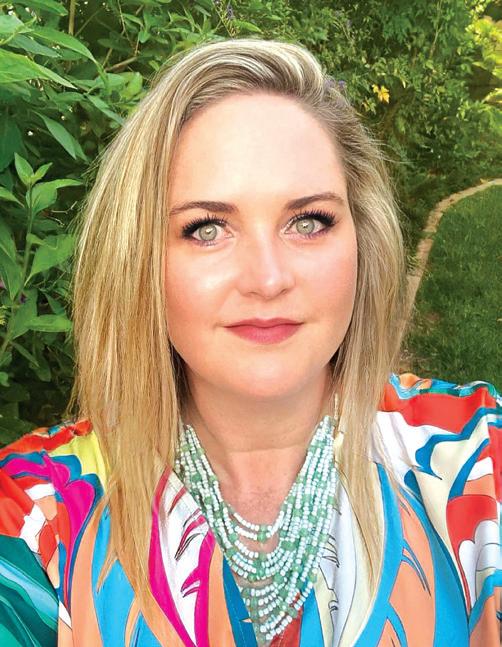
She spent 10 days in George Medi-Clinic’s ICU, suffering from kidney failure from suspected heatstroke and dehydration.
‘I woke up in the ICU with no idea what had happened,’ Clair said. ‘The doctors
After her discharge from hospital, Clair wrote this heartfelt message to the Plett NSRI team:
To the NSRI Plett team, thank you from the bottom of my heart for saving my life on 28 April at Robberg. Your courage, skill, and selflessness will never be forgotten. I am forever indebted to you and eternally grateful for the second chance you’ve given me. With all my gratitude.
CLAIR

We chatted to June van der Westhuizen who joined NSRI’s Fundraising Centre when it first launched in 1997. What’s the secret to this remarkable longevity and loyalty? We find out. By Wendy
Maritz
NSRI Fundraising Centre manager
Lianne Daniels-Lategan describes June van der Westhuizen as an excellent fundraiser. In an industry that can often be unforgiving and difficult, June has proven that with persistence and sincerity, you can win people over to a cause you believe in. And for June that’s the NSRI.
The Car Competition that many readers will be familiar with has been running for 28 years, and June was one of the original members of the team that began selling tickets for this now well-supported annual
competition. At the time, she was running an aftercare having been a teacher for many years. ‘I was actually asked by a friend of former CEO Ian Weinberg if I would be interested in becoming part of a call centre to get this fundraising idea off the ground,’ she recalls. ‘I was one of a handful of people – there were maybe four or five of us – selling tickets to win a car.’
‘Tickets were R150 each and everything was done manually. We couriered the tickets to supporters who usually paid by cheque. There were no computers in sight,
and no cellphones either,’ she says, smiling. ‘It was a small, busy team that grew steadily over the years, especially after the Monthly Giving Competition was added into the mix in 2001, and supporters could buy monthly tickets and be entered into a draw to win monthly cash prizes and a large annual cash prize.’
Over the years, the growth was accompanied by better technology that made the mechanics of selling much easier. ‘We have a completely paperless system now,’ June says. ‘You know, in those first few years, we sold between 2 000 and 3 000 tickets for the Car Competition a year; now we sell that amount every month. But the Fundraising Centre is more than 60 people strong now, so it’s really grown tremendously and the fundraising has been phenomenal.’
Over the years, June has become familiar with many NSRI supporters. In fact, she was fondly nicknamed Die Bootmeisie van die Kaap (The Boat Girl from the Cape) by upcountry donors. ‘The donors are incredibly loyal,’ she says. ‘Many have been supporting us for between 15 and 20 years via the competitions. That loyalty is what keeps me going.’
June also alludes to the NSRI family. ‘I think this differentiates us from other organisations. Within the NSRI you’ll find children following their parents’ footsteps by joining the station where their mom or dad are volunteers. That idea of family extends to donors and supporters, who become like family over the years. And it’s very evident here in our Fundraising Centre team too.
‘An average day here involves making a lot of calls so it’s a vibrant, busy place,’
The Fundraising Centre consists of 55 fundraisers, excluding manager Lianne Daniels-Lategan, four assistant managers who manage squads within the team, and two admin assistants. Lianne joined as assistant manager on the Monthly Giving (Debit Order) campaign in 2011 (‘It was my little baby’) before becoming overall manager at the beginning of this year.
The first thing Lianne did was ‘break the divide’ between the two competition campaigns. ‘The Car Competition and Monthly Giving fundraisers always sat separately and we had this white wall dividing us. We literally broke it down, but not before we wrote positive messages all over it. So, now we have Car Competition fundraisers sitting next to Monthly Giving fundraisers and it’s created such camaraderie between the two campaigns. Now it’s about how can we make this work together. I really wanted to create a positive environment. It’s like June said, we laugh a lot, and joke a lot. We have to because sales is tough and can be quite stressful,’ Lianne explains.
Part of what makes it challenging is that you’re not selling a tangible product. ‘We’re asking people to give us their hard-earned cash, so I try to make sure every member of the team has a positive mindset. One has to be tenacious to make it through the tough calls too,’ she adds. ‘I also tell the fundraisers
to never take things personally, and to remember that you don’t know what’s happening in the life of the person on the other end of the line,’ she adds.
‘We’ve often had people emailing us to apologise for being rude over the phone. It shows just how well the fundraisers do their jobs, because the person might not remember anything else except that it was someone from the NSRI calling. Our fundraisers believe in what they’re selling and love the NSRI brand. This also helps them take the knocks with a bit more resilience.’
Aside from believing in what you’re doing, Lianne adds consistency and determination among the traits important to be a successful fundraiser. ‘Someone like June brings that to the table. She’s been doing this for 28 years, and for as long as I’ve known her, she is the same every single day. She’s a wonderful example to people who join the team. She comes in here every day, positive and smiling, she motivates people. She’s got such a lovely way about her. She’s energetic and enthusiastic and it’s infectious.’
While members of the NSRI family generally don’t like to pat themselves on the back, it speaks volumes that the Fundraising Centre has an incredibly low staff turnover, and that people like June van der Westhuizen have remained steadfast to the fundraising cause for 28 years. Thank you, Lianne and Co, for keeping this vital NSRI function running so smoothly and with such love and passion.
‘Within the NSRI you’ll find children following their parents’ footsteps by joining the station where their mom or dad are volunteers. That idea of family extends to donors and supporters,
who become like family over the years.’
June says. ‘Oh, and it’s very competitive, too. But it’s a healthy competition. We laugh and joke around a lot! It’s a happy place.’
And what about those days when there are more negative responses than positive ones, more ‘No, thank you’ than ‘Yes, tell me more’?
‘It’s part of the job,’ June says. ‘Then you just have to move on. What makes up for it are those people who do say yes, the ones who have compassion, will listen to what you have to say. I mean, sometimes, I’ll have a donor on the phone chatting to me for 20 minutes about their lives.’
When June is not working, she loves to read, spend time with her youngest son and his family (her oldest son lives abroad) and spend time down at the beach. ‘I love the ocean and have been blessed to live near the sea my whole life. I’ll walk my dogs on the beach every day. It’s a gift to be able to do this and every day is different.’
Does Die Bootmeisie van die Kaap have any plans to retire? ‘This place keeps me young,’ June (68) says. ‘They’re an amazing bunch of people, and at various times have really helped me get my head around some of the technology challenges.
But we were all in the same boat when we went onto CRM about two years ago.’ (For many years the Fundraising Centre was outsourced and housed in premises away from the main NSRI Head Office that was originally located in Three Anchor Bay, but the fundraisers are now fully integrated into the Volunteer Support Centre in Marconi Beam near Milnerton in Cape Town where the NSRI moved to in 2021.)
It’s been 28 years since the Car Competition was launched, and June made her first phone call. She remembers a chat she had with her son who wanted to know
what the word ‘synonymous’ meant. She said, ‘Well, Franck, if you say NSRI, the Car Competition is synonymous with the NSRI.’
It surely has come to be so, and June played a vital role in getting it off the ground, and continues to keep it ‘synonymous’. Yes, it’s incentivised giving, June acknowledges, but ‘I always tell the people I call that I’m not selling them anything, I’m asking them to help us save lives.’
And, of course, it gives her great joy to see who the winners are during the course of the year. ‘It’s a way of giving and receiving,’ she says. ‘It’s wonderful.’

Believing in what you do has been the secret to the staying power of members of NSRI’s Fundraising Centre. That, and a supportive environment, and a bit of healthy competition.
The NSRI’s Water Safety footprint has grown in leaps and bounds since its inception in 2006, with representation now present in every province in South Africa. We caught up with four Water Safety educators to find out why they do what they do and to share special moments in the classroom. By
Wendy Maritz
A passionate educator, Brendan joined the Water Safety team in June 2022, inspired by the fact that he could share essential life-saving skills with children in the Durban area. ‘The NSRI Drowning Prevention department prepared us well by hosting training sessions and workshops and provided us with all the tools we would need to run the classes,’ he says. Sometimes getting a foot in the door of a school is the first challenge, but Brendan says that 80% of the school bodies he reaches out to are quite willing to allow him to take over several of the regular school lessons to give his water safety presentation. And, after three years on the job, he’s learnt that so much depends on how you deliver that presentation. As is often the case, children can be a little shy or quiet in the beginning, as this
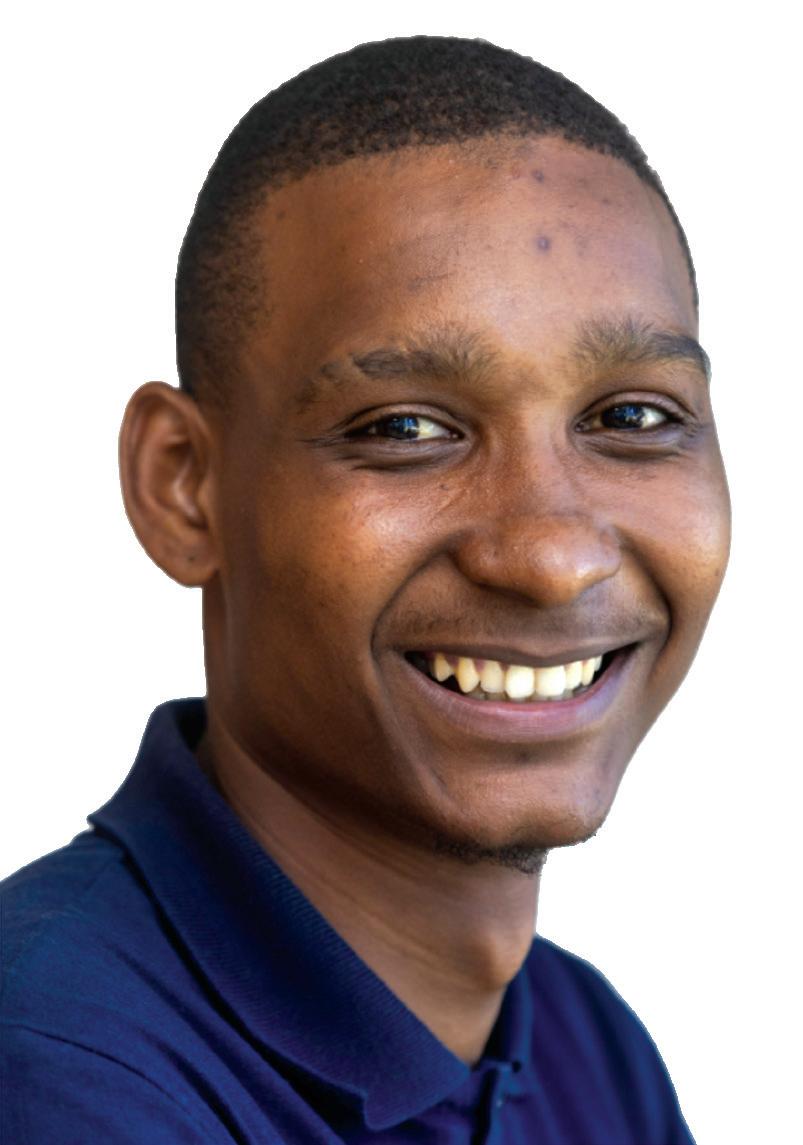
is something quite new to them, but once everyone warms up, ‘they respond quite positively and eagerly to the various topics covered’. The trick to teaching anything is to make it engaging by using role play as well as colourful teaching aids, and for older children, learning CPR using a dummy is a novel experience.
‘The most rewarding part of Water Safety education and Survival Swimming instruction is knowing learners will be equipped with water safety knowledge and we can reduce the number of drownings in our local areas,’ Brendan says. ‘What I’ve learnt is that education and knowledge play a vital role in our lives, and without it, prevention cannot happen.’ An incident that stands out for Brendan, and one
which illustrates this insight well, occurred when he was presenting a Water Safety workshop at a public facility. ‘A cleaner broke down in tears and explained her child had drowned the year before. She said, “If I’d known this earlier, I could have saved my baby.” I will never forget this, as it fuelled an even bigger flame for my passion and love for my job.’
Rose’s love for the ocean and a desire to help people gain knowledge about water safety led her to become a Water Safety educator almost 10 years ago, in July 2016. She has loved engaging with learn-

ers and has found over the years that the schools she approaches are happy to host her because they understand the value of what she is doing and because the lessons are offered at no cost to the schools. ‘The children respond very positively to the lessons and ask – and answer – lots of questions,’ she says. ‘When you approach a child with respect and patience, and communicate clearly, you’ll be surprised at how much they take in. Never underestimate a child’s capacity for learning and understanding.’ There’s a moment, she says, when you can see the ‘penny has dropped’, when a child gets what you’re saying, and comprehends how dangerous water can be. ‘When they can recognise danger, know how to help a friend or simply stay calm near water and follow the safety rules… It’s powerful. You’re not just teaching skills, you’re potentially saving their life.’ For Rose, Water Safety education can teach life-long habits. ‘It’s not just about passing on information, it’s about inspiring children to take it seriously and act on it,’ she says. She recalls a lovely moment in the classroom: ‘One water safety lesson involved role play. It was a group of
‘When they can recognise danger, know how to help a friend or simply stay calm near water and follow the safety rules… It’s powerful. You’re not just teaching skills, you’re potentially saving their life.’
Rose Ndaba
eight-year-olds. One student, who’d been quiet till then, volunteered to demonstrate how to use a pool noodle as a reaching aid and explained in his own words why jumping in to help wasn’t safe. Afterwards, his teacher told me that it was the first time he’d spoken confidently in front of his peers. It made me realise that practical lessons can bring out confidence in kids who might not usually shine academically.’
Linda had a childhood dream of becoming a teacher, a dream she was unable to fulfil due to financial constraints. Becoming a Water Safety educator (she joined the team in August 2015) was ‘her dream come true’. Linda’s work in the Western Cape covers Langa, Khayelitsha, Mfuleni and Delft, and a few schools in Du Noon, Strand and Mbekweni (situated near Wellington). Her role as teacher was well facilitated by the NSRI, as it emphasised the importance of discipline, teamwork and clear communication. And ‘the hands-on training we practised helped me anticipate any challenges that might crop up so that I could adjust my teaching methods accordingly’. One of the biggest challenges about arranging visits to schools is conveying exactly what the lessons are about. ‘We need them to realise it’s not about swimming lessons, but about being safe around water,’ Linda says. But, it’s rewarding work, she adds quickly, and children respond well, ask questions and engage with her and the material. The feedback after the lessons is very encouraging, from
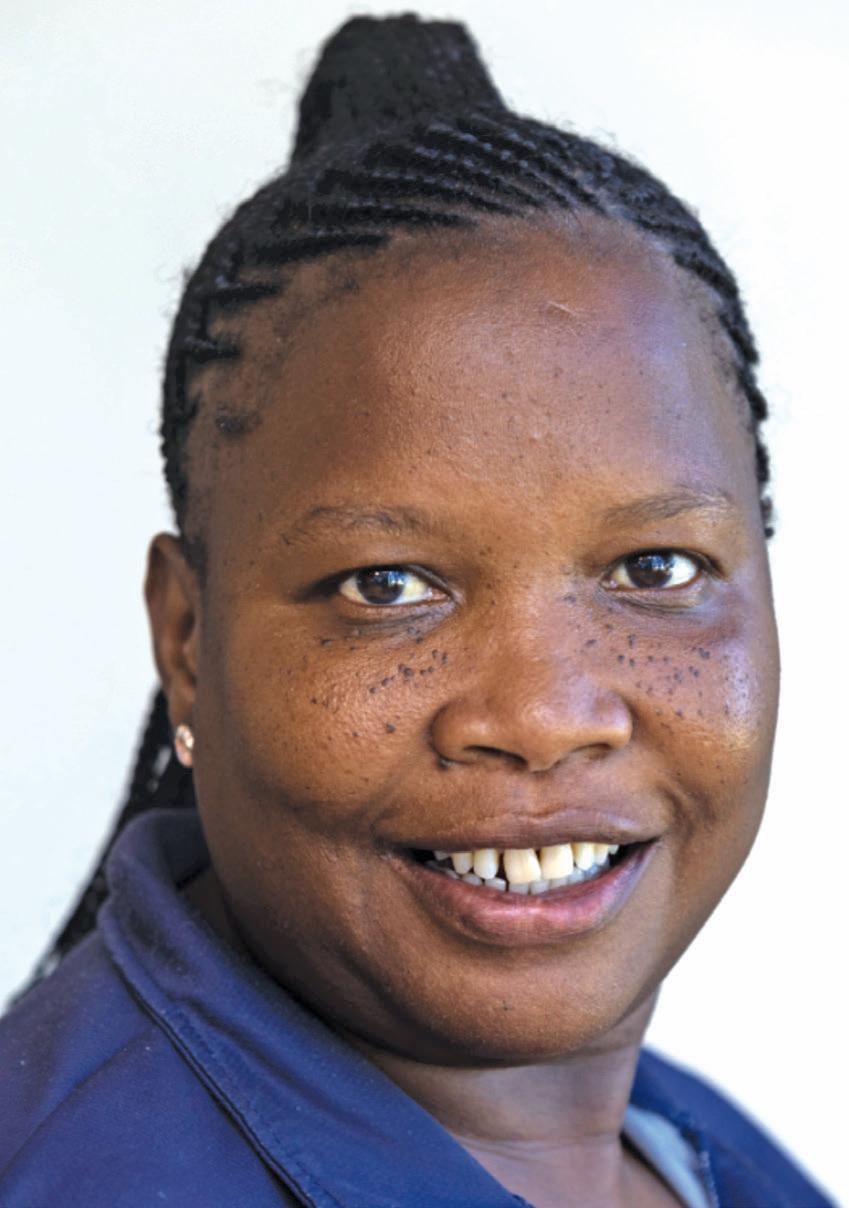
both children and teachers, and sometimes the smaller children will want to chat with her once the lesson is done. She recalls, smiling, how once when she was in a mall, she encountered a few children she had taught. They recognised her and began singing the 112 emergency number song she had shared with them. It’s also rewarding for her when learners’ parents become involved, expressing a desire to also learn more about water safety. Her work has not only profoundly changed her own life, or the lives of the children she’s taught over the years, but also came very close to home with one incident. ‘A few years ago, my late mother was not breathing and my sister’s daughter, who was 12 years old at the time, performed CPR on her successfully. I am still so proud of her as I had just taught a CPR lesson that month at her school.’
VUYOLWETHU MEKULA
Vuyo became a Water Safety educator in September 2015. She had not heard of the NSRI until then. ‘I first heard about the NSRI through a newspaper article that highlighted the amazing work they do to help people in drowning situations. I was also inspired by Daniel Heiman, who was a volunteer at the time. He shared stories about how the NSRI even helps animals in distress at sea, not just people. That really moved me and made me want to be part of the organisation,’ she explains. Vuyo works in the Gqeberha area, including New Brighton, Motherwell, Kwazakhele, Zwide township, Soweto-on-Sea and Veeplaas. Vuyo travelled to Cape Town for her training, and returned home armed with visual aids and a mannequin that she uses to demonstrate CPR. She loves how receptive the schools are when she approaches them to deliver her lessons. ‘When I arrive, the teachers assist by helping keep the learners quiet and ensuring they are seated and ready for the lesson. It makes a big difference,’ she smiles. The children, too, welcome her enthusiastically, even wanting to get on stage with her to help with the lessons. ‘They ask lots of questions, help me with the flashcards. They have such energy, and love learning about CPR.’ The most rewarding part? ‘Seeing how the children embrace the knowledge I share. The appreciation from the schools also means a lot. Drowning incidents happen often in the areas I work in, so it’s meaningful to know I’m playing a role in helping reduce those risks through education,’ Vuyo says.

Like her colleague Rose Ndaba in KZN, Vuyo recognises the moment a child understands the meaning and importance of water safety. She says, it might take a bit of coaxing, but by the end of the lesson, children are throwing their hands up to answer questions, vying for her attention, and willing to share stories.
‘I once asked them, “Who goes to the beach alone?” They deny it at first, but soon the real story comes out.’ But it’s when they understand how dangerous it is and how they need to adjust their behaviour that Vuyo knows she’s doing her job properly. ‘Personally, I’ve learnt the importance of meeting the learners where they are; getting to know them helps me to connect with them and also deal with the odd learner who’s having a bad day. I feel such joy when I see them actually reflecting on the knowledge I’ve shared with them.’
When NSRI crew are tasked with rescues along rocky cliff paths, another whole set of challenges comes into play. Being able to secure a casualty at dusk and manoeuvre along a treacherous path as darkness settles while keeping them still and safe takes patience, calmness and skill. By Cherelle Leong
Many of our smaller NSRI stations cover a large stretch of coastline because of their remote locations. However, they’re strategically positioned because of their proximity to tourist areas known for outdoor recreational activities. Oyster Bay (Station 36) and Storms River (Station 46) are two such stations. Based near the Tsitsikamma Forest and the pristine and jagged coastline of the world-famous Otter Trail, the volunteer crew regularly train for rescue scenarios on land and sea, as well as combinations of both.
They know the coastline intimately, including the areas of the coast where they can safely get crew to shore and evacuate casualties by sea if necessary. The crew also regularly sharpen their first-responder
NSRI crew and rangers from SANParks navigate the tricky terrain to assist a hiker to level ground.
skills, ensuring they know how to stabilise patients until they can reach more advanced medical care. This is vital, as NSRI crew are often the first rescue services on scene and need to be able to provide primary care.
Imagine having to hold a patient’s neck stable for two hours as the rescue vessel carefully makes its way through rough seas
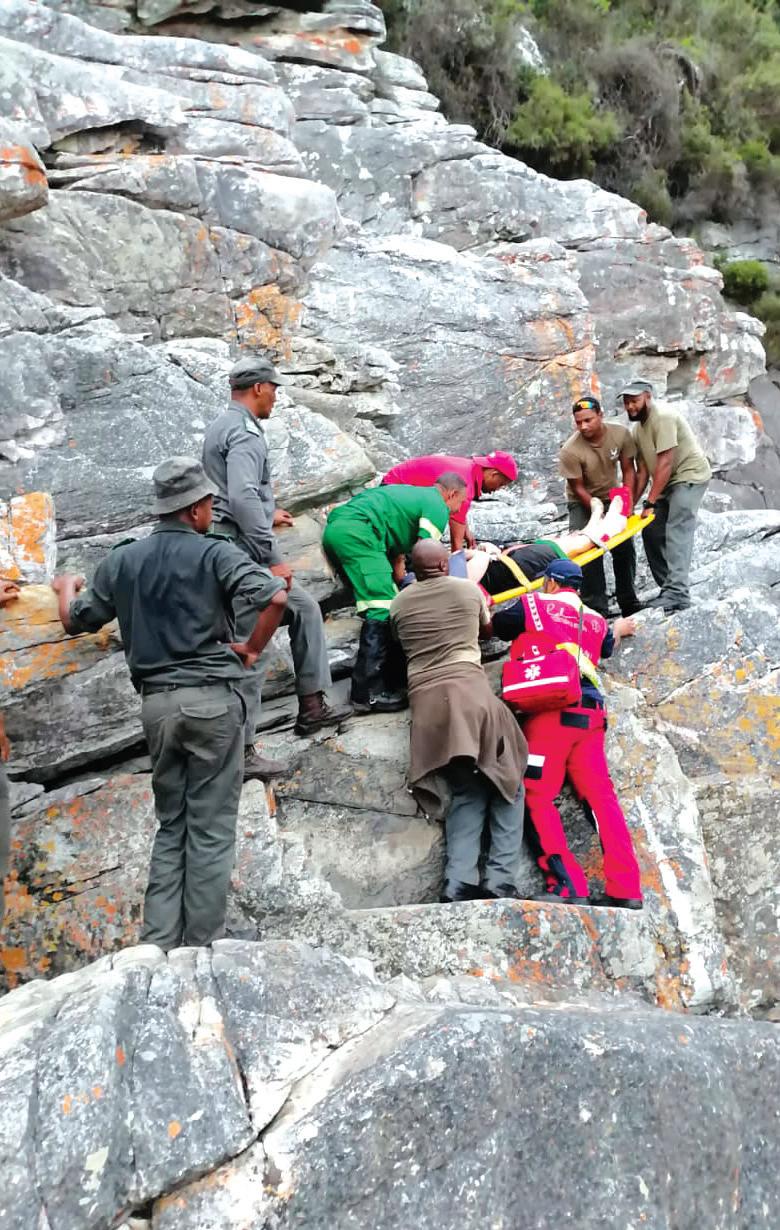
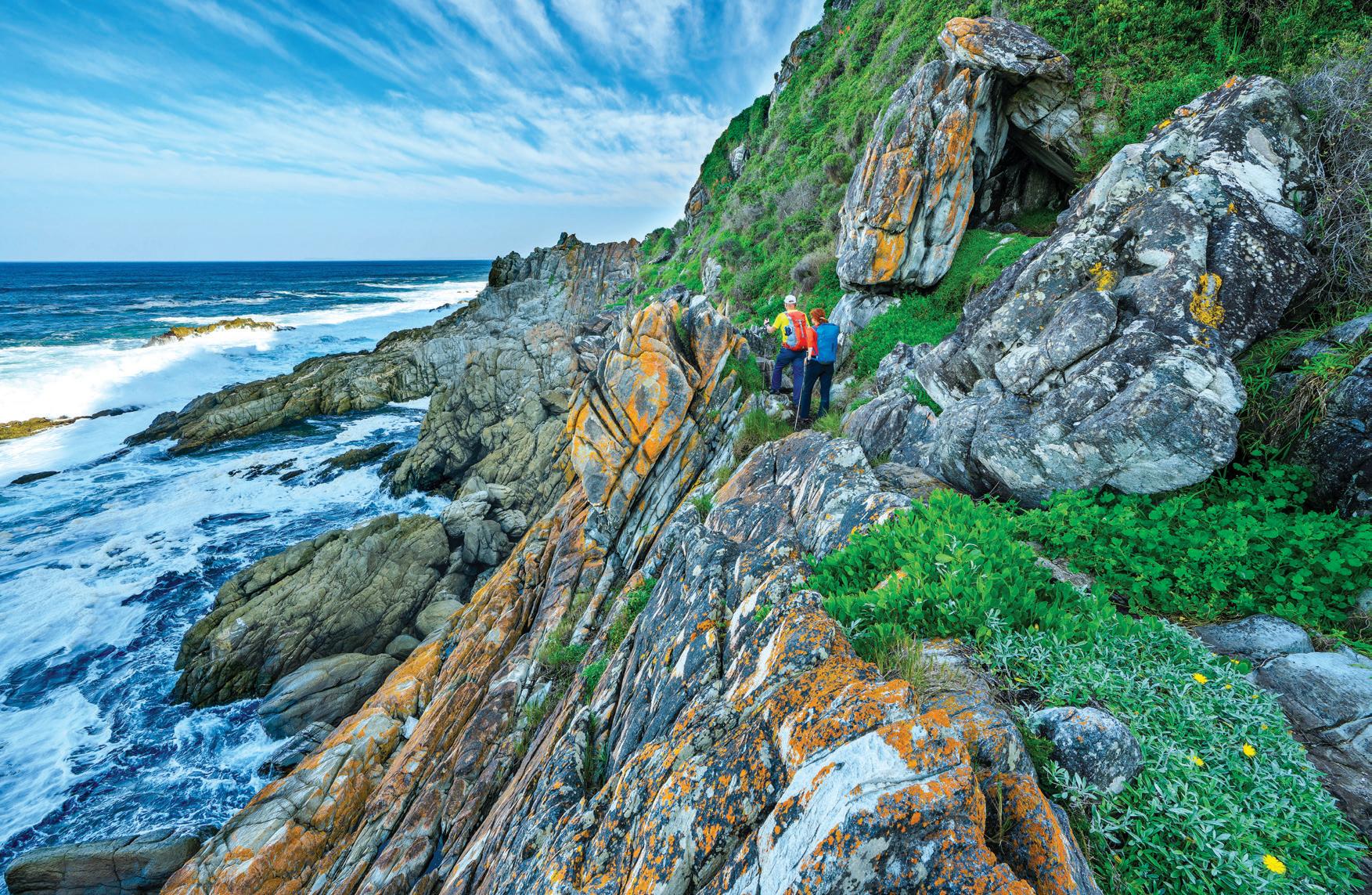
back to base, the efforts likely preventing further injury and possible paralysis. Consider having to navigate large boulders on a rocky shoreline for almost three hours in the dark, while carrying a patient on a stretcher to get them to an ambulance. Or handling a similar casualty carry-out, but in the rain, at night, with the rescue operation taking seven hours to complete.
It’s this level of dedication and teamwork that makes the small contingent of volunteer crew at Oyster Bay and Storms River so effective. When a call comes in, even if it’s as the sun is setting on a Saturday evening, they don’t hesitate to respond.
On 19 April, rescue crew from both stations were activated following reports of a 61-year-old hiker injured near the Waterfall at the start of the Otter Trail. She was part of a small hiking group and they were attempting to get her back to safety at the Storms River Mouth parking lot. With
progress slow and daylight fading fast, the hiking party had called for help. SANParks, knowing the level of skill and experience of the Sea Rescue crew, had asked for their assistance in evacuating the injured hiker.
Working together with the SANParks rangers, the volunteer crew set out along the trail, carrying with them a stretcher and medical equipment, as well as extra water and supplies for the rest of the hiking party. Meanwhile, additional crew responded to the bases to prep the rescue vessels in case they needed to launch and evacuate the casualty by sea. Relay ambulance services also responded to the Storms River Mouth parking lot, ready to receive the patient.
It was fully dark by the time the rescue team rendezvoused with the hiking party. First responders assessed the casualty and stabilised the injury before securing her into a stokes basket stretcher. That was
the easy part of the operation. Carrying her out, in the dark, over rocky and challenging terrain took the best part of two hours, as it was slow going. The rescue team had to watch every step and make sure of their footing, all while making sure that the stretcher remained balanced. Once they reached the car park at Storms River Mouth, the rescue team handed the casualty over to the waiting ambulance. After a medical assessment, she was released into the care of her family and opted to see a doctor privately to attend to her injuries rather than be transported to hospital.
It was late by the time the NSRI crew headed home. Little did they know that the versatility of their rescue skills would be put to the test for a second time that weekend.

It was just after midday on Sunday 20 April, when the next call came through: another injured hiker, this time a 54-yearold male. The incident had occurred near Guano Cave along the shoreline, and the decision was made to launch the Storms River rescue craft Spirit of Sam to extract the casualty. The vessel deployed two rescue swimmers to shore, who found the casualty in a serious but stable condition. The decision was made to transfer him to the Spirit of Sam, as this would be the fastest way to get him back to Storms River Mouth, where the waiting paramedics could provide further medical care.
SANParks rangers and NSRI crew from Storms River and Oyster Bay carefully carry the casualty along the trail to rendezvous with ambulance and medical personnel.
Once again, rescue crews from Storms River and Oyster Bay worked together to secure and transport the casualty from the rocky shoreline onto the rescue craft, concluding a successful rescue by 15h30.
While it’s not common to have two rescues on the same trail in two days, it does highlight how a single misstep when hiking can result in a serious injury. Fortunately for hikers, there’s a small but highly capable contingent of NSRI volunteers willing to provide assistance when needed and come to the rescue.
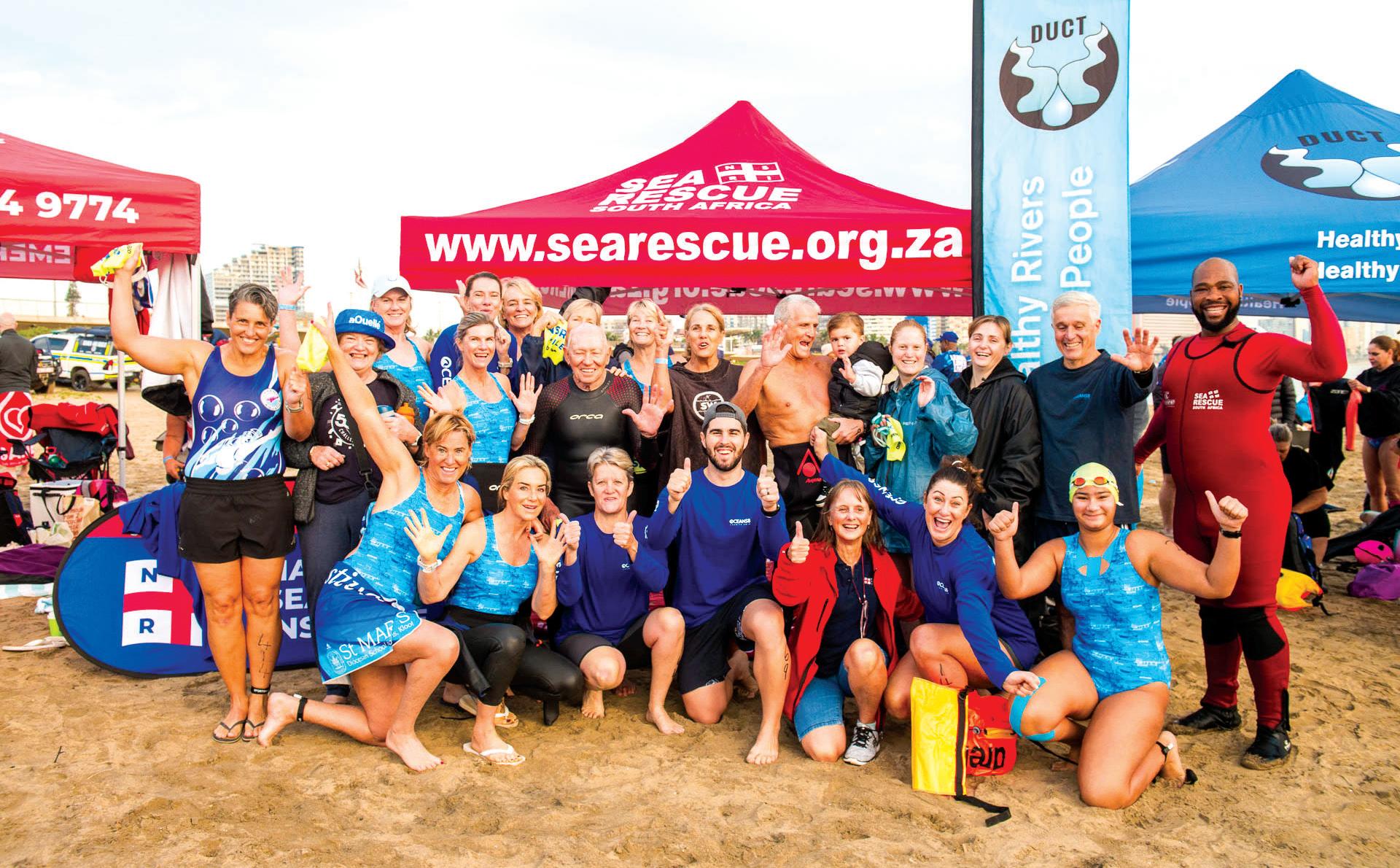
The Oceans 8 Charity Swim made a triumphant return over the weekend of 14-16 June 2025. Held at the Durban Undersea Club, this event is not only a celebration of endurance but also a powerful force for good: organised by charities, for charities.
This year, the event reached new heights, raising R1.1 million in support of 14 deserving causes. A collaboration between four key NPOs (the NSRI, Duzi Umgeni Conservation Trust, Project Rhino, and Singakwenza Early Childhood Education), the Oceans 8 Charity Swim challenges participants to raise funds in addition to testing their mettle in the ocean.
Swimmers may register for either the 8-mile or 16-mile swim, with each participant committing to raise a minimum of R5 000 for their chosen charity. Every cent raised is donated to the associated charities.
This year, the NSRI was proudly represented by 29 swimmers in the 8-mile event and five swimmers in the 16-mile category. Together, they raised over
R250,000, which will be allocated to NSRI Durban and Ballito. Among these ocean heroes was Mathew Pelser, who not only completed the full 16 miles but also consistently clocked the fastest times for each lap – a remarkable feat of endurance and speed. The NSRI extends a heartfelt thanks to every swimmer who took part, whose grit, determination, and fundraising efforts made an incredible impact
In just three years, Oceans 8 has become known for its exceptional organisation, emphasis on safety, and warm, inclusive atmosphere. It brings together hundreds of individuals united by a common purpose: to enjoy themselves while giving back.
The success of the 2025 Oceans 8 Charity Swim was made possible through the incredible generosity of sponsors and donors. Whether through financial contributions, services or the donation of goods, their support enables 100% of the funds raised to go directly to charity.
Our thanks goes to the Royal Cape Yacht Club for inviting us to the Sable International Twilight Series prize-giving held at the end of March, as well as for the generous donation of funds raised. Since 2021, the Sable International Twilight Series has raised more than R150 000 for the NSRI, with total donations amounting to more than R200 000 with Summer Series donations included.

100% of the funds received from each yacht’s entry fee towards this event are donated to the NSRI.


Years ago, on a beach in East London, Ann Stratford watched as her husband Eric taught a young boy to bodysurf. Then, in an instant, joy turned to fear as a rip current swept them out to sea.
‘The child’s grandmother and I were on the beach, and when I looked up, there were two specks on the horizon,’ Ann recalls. ‘The rip had taken them so far out. I ran to the NSRI, and two guys went out and rescued them.’
Eric kept the child afloat until help arrived. ‘When he got back to the beach, he was just so grateful someone like the NSRI was there,’ she says.
That moment never left him. Eric later made provision in his will to support the NSRI, and when he passed away in 2016, his bequest – wisely invested – funded not one but two state-of-the-art JetRIBs.
Thanks to Dries van Rooyen of Discovery, who invested Eric’s legacy so well, the NSRI was able to purchase both rescue vessels: the Eric Stratford, stationed at Plettenberg Bay, and the Ann Stratford, based at Wilderness, a location close to Ann’s heart.
Ann’s bond with the NSRI deepened after Eric’s passing. At a talk hosted by the Plettenberg Bay Probus Ladies Club, she shared her story and joined the NSRI’s Life Boat Club to stay connected.
‘I heard the Ann Stratford rescued a couple of friends caught in a rip at Wilderness, just like Eric had been,’ said Ann. ‘That was so special to me.’
On another occasion, she learned a rescue wouldn’t have been possible without the Eric Stratford. ‘That gave me goosebumps,’ she said. ‘What you guys do is amazing.’
Ann still visits the Plett base occasionally to watch training runs. ‘One Wednesday, I asked where the Eric Stratford was, and they said she was still out. I waited until she came back. I am incredibly proud.’
Rev. Tim Rist blessed both vessels and the brave men and women of the NSRI stations who crew them, often in extremely dangerous conditions.
At Wilderness, NSRI Station Commander Jonathan Britton reflected on what it means to serve aboard a legacy vessel.
‘The Ann Stratford is more than a rescue craft. She’s part of our crew,’ he said.
‘Thanks to Ann’s generosity, this vessel has become a vital part of our station’s story.
Legacies like Ann’s reach far beyond equipment. They shape people. They build resilience, not only in those we rescue but in
‘I heard the Ann Stratford rescued a couple of friends caught in a rip at Wilderness, just like Eric had been. That was so special to me.’
Ann
Stratford
the lives of those who choose to serve. She’s a classroom. A proving ground. A place where future leaders have found their feet. It’s where our first female coxswain trained and earned her place at the helm – a milestone that speaks to how legacy lifts us all.
‘To crew a legacy vessel is both a privilege and a responsibility. We honour not only the vessel itself but also the story and generosity behind her. Every callout, every training session, every quiet hour of preparation keeps that legacy alive.
‘Without support from individuals, businesses and bequests like Ann’s, we couldn’t do what we do, whether it’s teaching survival swimming or water safety or using the very best equipment to keep crew and those in distress safe.’
Ann may never meet the people saved by her gift, or the crew whose skills were forged aboard her namesake vessel, but her legacy continues to ripple outward.
‘Legacies like Ann’s remind us that rescue isn’t just about the headlines,’
Jonathan says. ‘It’s about quiet resilience, community, care and connection. That legacy launches with us every time we go to sea, and come back home.’
For more about NSRI’s Life Boat Club, contact Gerrie Niemand on 066 489 0285 or email gerrie@searescue.org.za.

The end of May saw heavy storms hitting Cape Town, and some parts of TEARS Animal Shelter were flooded. NSRI Simon’s Town, Kommetjie and Hout Bay dispatched crews armed with water-extrication pumps to assist with clearing the affected areas of the shelter. No animals were in any urgent danger or needed to be evacuated. Water was pumped to an area that had better drainage, said Simon McDonnell, Simon’s Town Station Commander, who added that NSRI is always happy to assist the community in these kinds of incidents.
TEARS took to social media with a heartfelt thanks to all involved. ‘Earlier today, heavy rains caused serious flooding at TEARS, especially in our dog kennels. But thanks to the fast action and support of our community, we were able to prevent a disaster. We want to extend a massive and heartfelt thank you to the amazing NSRI teams from NSRI Station 10 (Simon’s Town), Station 8 (Hout Bay) and Station 26 (Kommetjie). Your incredible support in helping pump out floodwater from our kennels made all the difference. We are so deeply grateful for your kindness and quick response.’
On 3 May, the NSRI officially celebrated the blessing of Bay Guardian, its latest state-of-the-art Offshore Rescue Craft (ORC), at a ceremony at the PE Deep Sea Angling Club.
Since its arrival at Station 6 on 25 September 2024, Bay Guardian has already demonstrated her capabilities, logging 49 training hours and 52 operational hours, conducting 15 rescue missions, and assisting 14 people in difficulty, including eight urgent medical evacuations from passing ships.
Former Station Commander Justin Erasmus praised the impact the vessel has had on operational safety: ‘The crew at Station 6 were very excited about the arrival of our new rescue boat,’ he says. ‘She has made, and will continue to make, a huge difference in our crew’s safety and






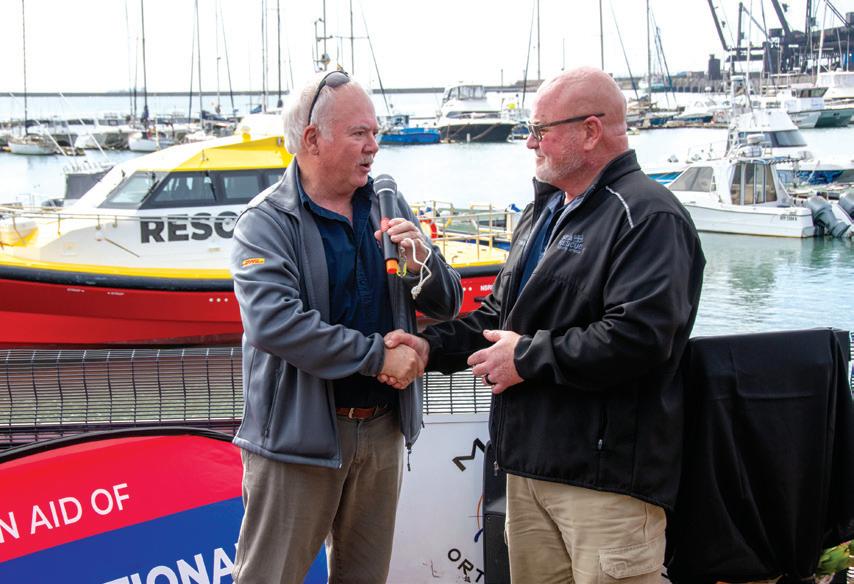
Retired NSRI Capital Projects Director Mark Hughes hands the keys for the NSRI’s new Offshore Rescue vessel Bay Guardian to former NSRI Station Commander Justin Erasmus.
the operations we can undertake. She represents a significant improvement on what we were accustomed to, and we have adapted our training to safely and effectively operate this highly advanced rescue vessel.’
Bay Guardian also carries a special tribute through the NSRI’s ’Celebrate a Life’ initiative: 739 names have been inscribed in the letters RESCUE 6 on the side of the cabin, raising over R700 000 for the vessel’s build. Each inscription honours a loved one, ensuring their legacy goes to sea with every mission.




A&M Logistics (Pty) Ltd / Applied Mineral Technologies (Pty) Ltd / Barpro Storage SA (Pty) Ltd / Life Health Solutions / MACS Maritime Carrier Shipping (Pty) Ltd / Marine Solutions (Pty) Ltd / NCS South Africa / Richards Bay Coal Terminal (Pty) Ltd / Ruwekus Fishing (Pty) Ltd / Two Oceans Aquarium Trust
THANK YOU FOR DONATIONS RECEIVED IN MEMORY OF: Gary Larkan, Dr L Snyman TO HONOUR: David Robins (retirement), Steven and Denise Boers (50th wedding anniversary), Peter Evennett (90th birthday), Kai Albrecht (birthday), Wesley and Jodie Carpenter (for their incredible kindness and generosity).
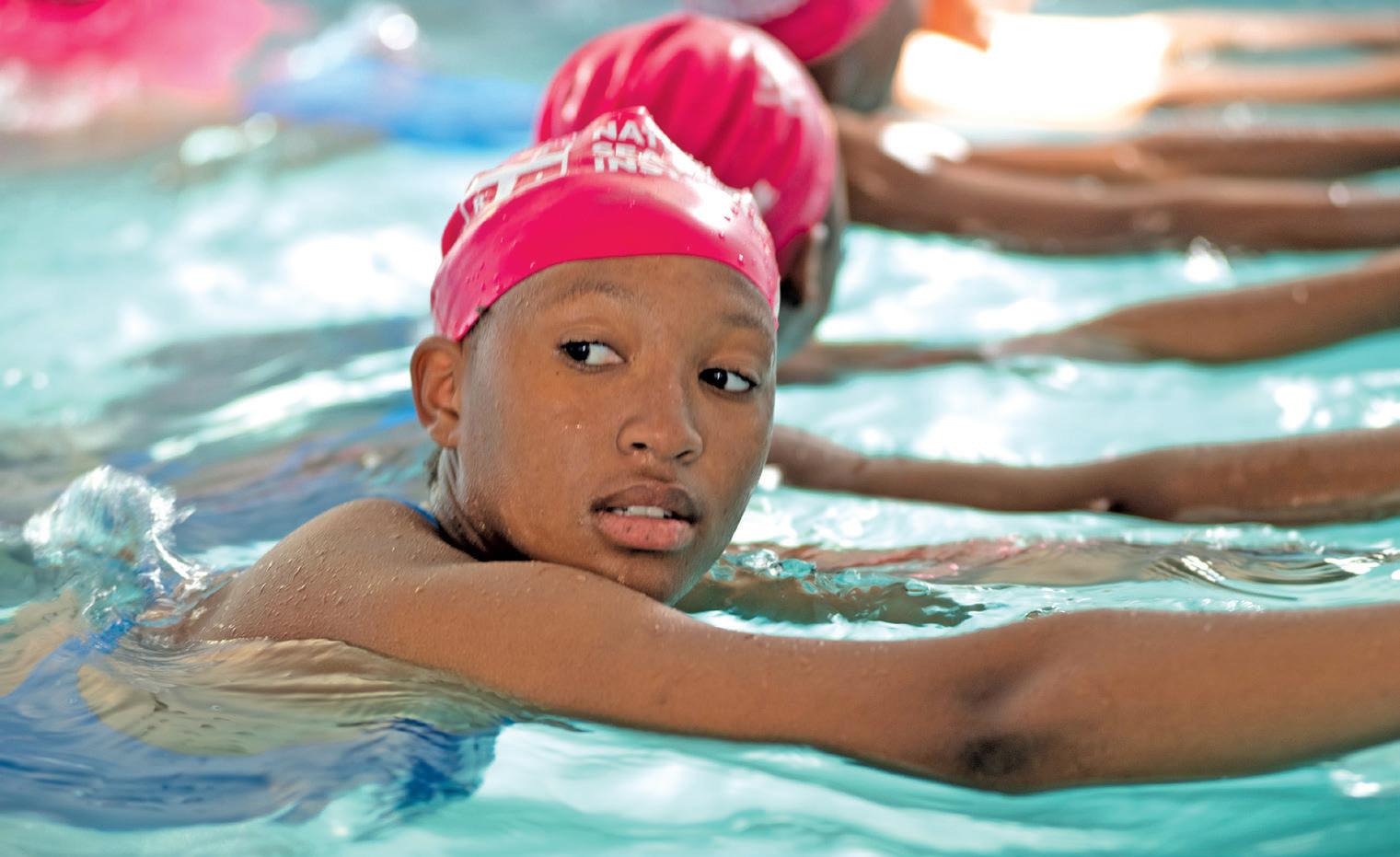
NSRI’s Survival Swimming programme is among the projects that has benefited from I&J’s support. We offer our sincere thanks to our Platinum Partner, I&J.
As a committed Platinum Partner of the National Sea Rescue Institute (NSRI), l&J is proud to endorse an organisation whose tireless efforts have a profound and lasting impact on the safety and wellbeing of South African communities.
I&J Marketing Manager Nicoletta Mattioli says: ‘The NSRl’s work in water safety and rescue embodies professionalism, dedication, and compassion. From lifesaving operations to public education campaigns, they play a critical role in safeguarding lives and promoting awareness about water safety. Their consistent drive to make a difference aligns closely with l&J’s values of responsibility, integrity, and community care.
‘Our partnership with the NSRI has been both rewarding and inspiring. Their transparent use of resources and clear communication with l&J have reinforced our confidence in their ability to deliver measurable and meaningful results.They
are an organisation that truly maximises the support they receive for the greatest possible benefit.
‘Through their exceptional management and unwavering focus on impact, the NSRI has become a trusted leader in maritime
The NSRl’s work in water safety and rescue embodies professionalism, dedication, and compassion. From lifesaving operations to public education campaigns, they play a critical role in safeguarding lives and promoting awareness about water safety.
safety and drowning prevention. We are proud to support their mission to create a water-safe nation and would wholeheartedly recommend them to any organisation seeking to contribute to meaningful change.’
A female bubble raft snail using her raft to float both herself and her developing eggs.
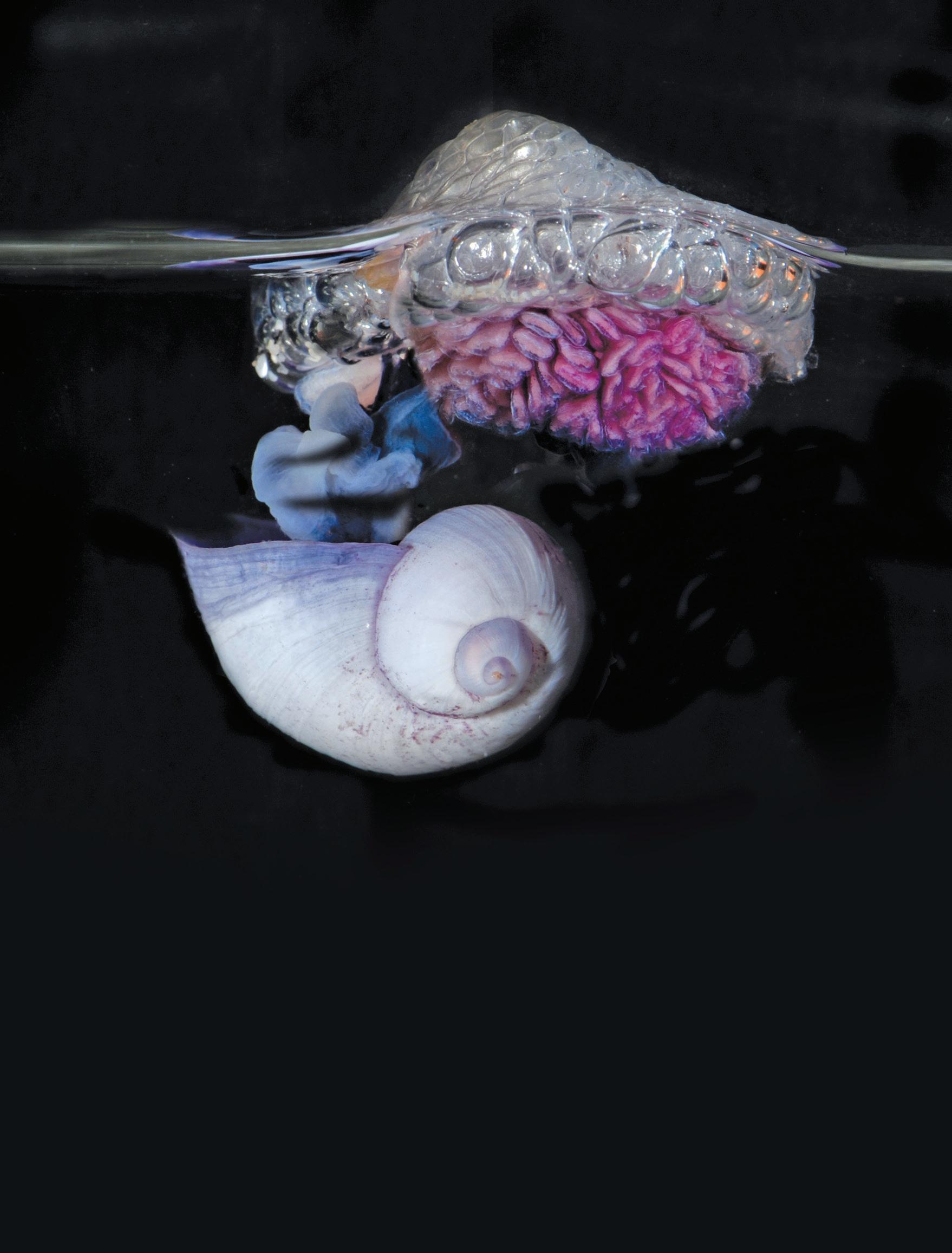
MBubble raft shells spend most of their lives hanging around, quite literally, on or just below the ocean surface. Naturalist Georgina Jones shares more about these fascinating little creatures.
ost people only see bubble raft snails stranded on the beach after storms – so much so that in some parts of the world these fascinating animals are known as storm snails. They are, however, the largest species in the ocean neuston, occupying an environment covering 40% of the planet’s surface. The ocean neuston is the community of organisms that live on or just below the surface of the open ocean, and it includes stinging animals such as bluebottles, by-the-wind sailors and blue buttons; floating molluscs such as sea swallows, and pelagic crustaceans, the buoy barnacles, along with a host of micro-organisms. Being the largest species in the ocean neuston doesn’t mean that they’re really big: the largest females are
They make the raft themselves, either using existing surface bubbles or churning the water with their agile feet to create them.
seldom more than 4cm across. Their shells are extremely thin and fragile; a compromise between protecting the animal’s vulnerable soft body and minimising the weight burden on the bubble raft.
They make the raft themselves, either using existing surface bubbles or churning the water with their agile feet to create them; and then surrounding the bubbles with a transparent chitin membrane secreted by a gland in the foot. Rafts can be up to 12cm long and are critical to the snails’ survival since they cannot swim in their adult form and will sink to the bottom and die if the raft is lost.
They live their lives hanging upside down from their rafts by their feet, floating passively in the wind and surface currents. They are usually found in the neuston in large groups several square kilometres in size.
They are extremely successful predators and are remarkably undiscriminating in their prey, even cannibalising members of their own species. A contributor to the success of their predation strategy is the secretion of a purple dye that paralyzes prey so they can more safely feed. Stomach content analysis shows that these snails prefer to eat by-the-wind sailors (Velella species). These are small,
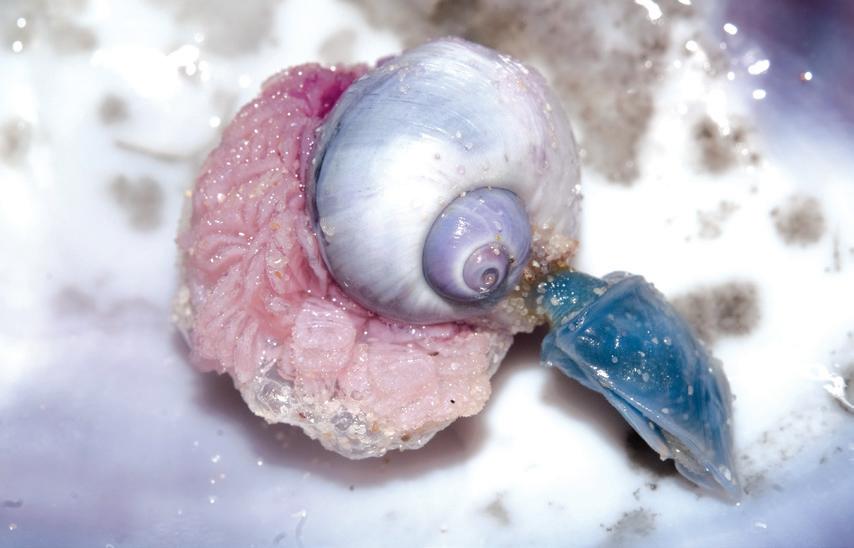
Buoy barnacles will sometimes attach themselves to bubble raft snails, saving themselves the effort of making their own buoys.
flat, transparent to blue hydroid colonies with a stiff little membrane that stands up above the ocean surface and acts as a sail. They have a skirt of stinging tentacles to stun and trap their prey, but bubble raft snails are able to withstand the toxins in the stings and use their rasping tongues to slowly consume the hapless little sailors. Though unable to swim as adults, bubble raft snails start life as relatively standard marine snail larvae known as veligers. These are free-swimming but once metamorphosis to the adult form begins, the bubble raft must be produced. Bubble raft snails are sequential hermaphrodites, starting out life as males and only later and at a larger size developing female organs.
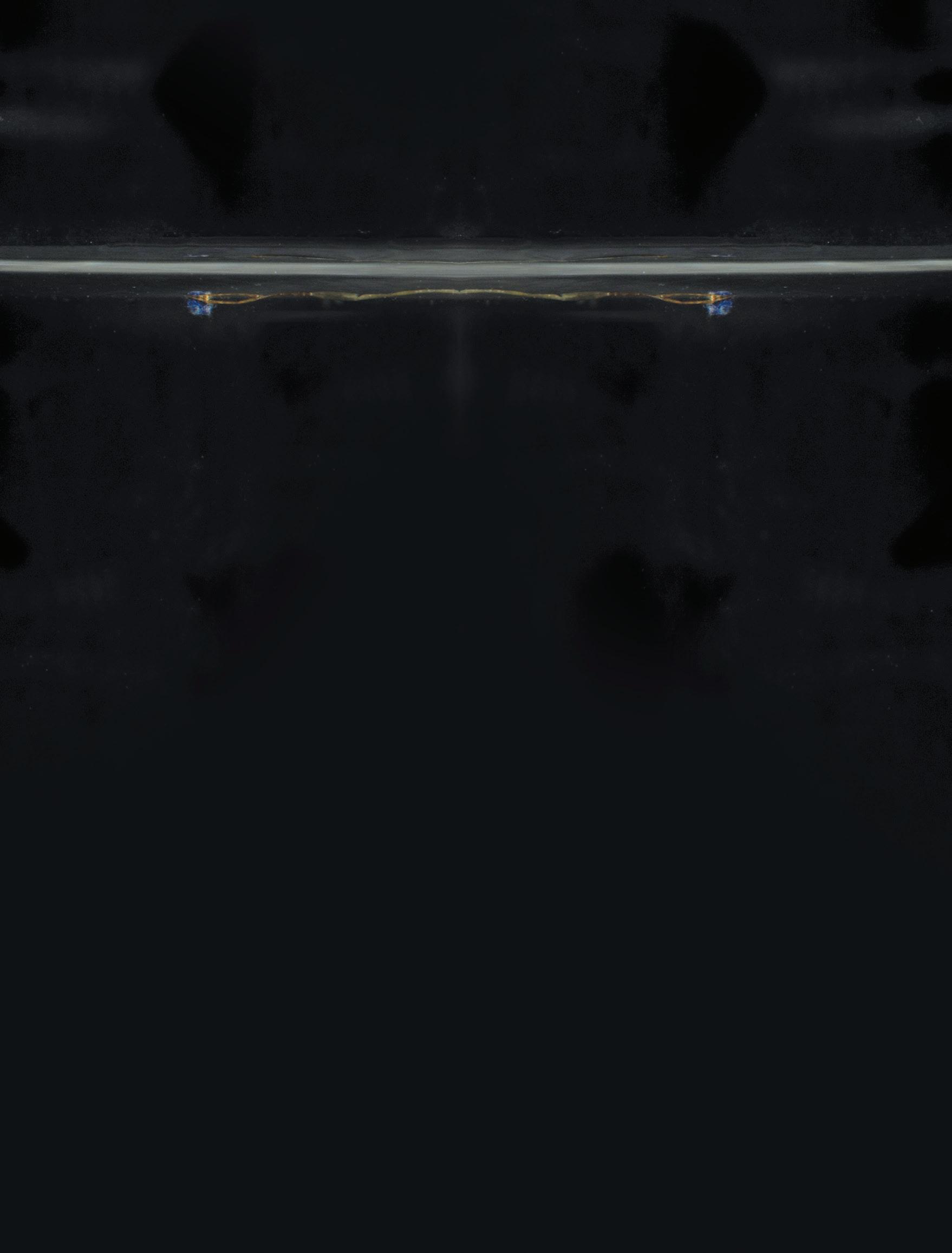
In most species, the females produce pinkish egg masses which are attached to the float and individual eggs develop into the free-swimming veliger larvae.
Bubble raft snails are a group of fewer than 10 species belonging to a large family of about 630 species of snails known as the wentletraps, all predatory or parasitic on bottom-dwelling anemones and corals, and all, except for the bubble raft snails, living on the ocean floor. Genetic and morphological studies have shown that the bubble raft snails’ development of the bubble raft was likely as a result of changes in the egg mass.
Other snails in their family have smaller males that stay associated with the larger females, themselves attached to the eggs. Studies suggest that the ancestral bubble raft snails’ were bottom-dwelling and that
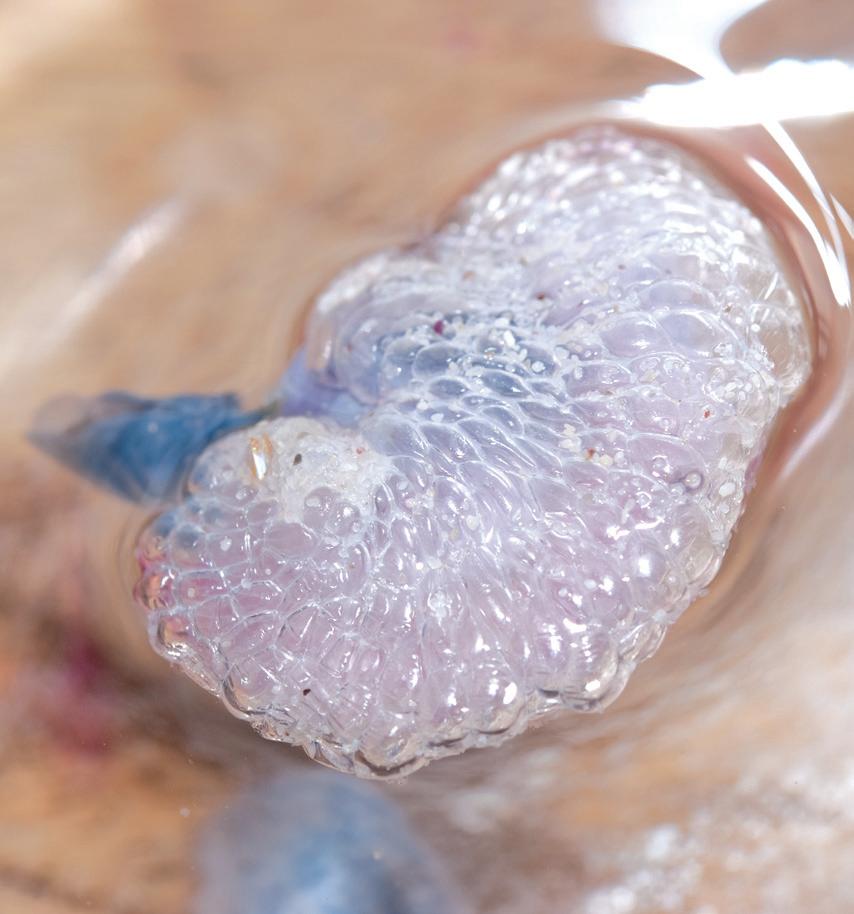
Because of the snail living upside down in the water column, it is countershaded, with one paler surface and a darker purple on its other side.
their egg masses started to become buoyant as developing larvae hatched and left the egg husks. This then developed over evolutionary time so that today there is a species in which the float is made only by the females and acts as a raft for the female, the eggs and the juveniles until they have developed enough to create their own rafts. In other species, once metamorphosed into the adult form, all of the snails have floats, with the females using them also as a raft for their egg masses. The most adapted species doesn’t produce an egg mass at all and develops its eggs internally, dispatching its veliger larvae directly out into the ocean to metamorphose in a prey-rich area.
Because of the snail living upside down in the water column, it is countershaded, with one paler surface and a darker purple on its other side. This is to conceal it from predators: fishes, birds, turtles and fastswimming squid are easily able to snap up the slowly drifting snails, and since their shells are far from sturdy, bubble raft snails must rely on camouflage to avoid their hunters. From below, the snail blends into the light-filled sky; seen from above they blend in with the surrounding ocean.
So these delicate floaters are safe from harm until a storm throws them up on a beach somewhere.
Bubble snails are amazing creatures that live just below the surface of the ocean. Test your knowledge and see how many of the questions you can get right. Don’t peek at the answers.
1. What are bubble snails known as?
2. Bubble snails are the largest species in the ocean .
3. How long can a female grow?
4. What do bubble snails make to stay afloat?
5. What do they use to paralyze prey?
Have some fun and colour the bubble snail in your favourite colours!
6. What are snail larvae known as?
7. What do bubble snails rely on for survival against predators?
8. Bubble snails belong to a larger group known as the .
See if you can find the following words: Bubble raft Snail Neuston Molluscs Eggs Shell Rafts Float Toxin Veligers
The NSRI is manned by more than 1 509 volunteers at 106 service locations including 56 rescue bases, satellite or auxiliary stations, inland dams and seasonal lifeguard units around the country.
Strandfontein (West Coast) (Aux)
Lambert’s Bay
Yzerfontein
Town
Survival Swimming Centres
SSC 1: Meiring Primary School
SSC 2: Noah Christian Academy
SSC 3: Duduzile Junior Secondary School
SSC 4: Sponsored on show in Spain
SSC 5: Steilhoogte Primary School
POP Pool 1: Portable pool at Pineview Primary School, Grabouw
› Data projectors and speakers or flatscreen TVs for training
› GoPros or similar waterproof devices to film training sessions
› Good-quality waterproof binoculars
› Prizes for golf days and fundraising events
› Towels for casualties
› Groceries such as tea, coffee, sugar and cleaning materials
› Long-life energy bars
› Wet and dry vacuum cleaners
› Dehumidifiers
› Small generators
› Good-quality toolkits
› Top-up supplies for medical kits
› Waterproof pouches for cellphones
› Tea cups/coffee mugs/glasses for events
NORTHERN CAPE
43 063 698 8971 Port Nolloth
WESTERN CAPE
45 066 586 7992 Strandfontein (Matzikama) (Aux)
24 060 960 3027 Lambert’s Bay
44 082 990 5966 St Helena Bay
04 082 990 5966 Mykonos
34 082 990 5974 Yzerfontein
18 082 990 5958 Melkbosstrand
03 082 990 5963 Table Bay
02 082 990 5962 Bakoven
08 082 990 5964 Hout Bay
26 082 990 5979 Kommetjie
29 082 990 5980 Air Sea Rescue
10 082 990 5965 Simon’s Town
16 082 990 6753 Strandfontein
09 072 448 8482 Gordon’s Bay
42 063 699 2765 Kleinmond
17 082 990 5967 Hermanus
30 082 990 5952 Agulhas
33 082 990 5957 Witsand
31 082 990 5978 Still Bay
15 082 990 5954 Mossel Bay
23 082 990 5955 Wilderness
12 082 990 5956 Knysna
14 082 990 5975 Plettenberg Bay
EASTERN CAPE
46 076 100 2829 Storms River
36 082 990 5968 Oyster Bay
21 082 990 5969 St Francis Bay
37 079 916 0390 Jeffreys Bay
06 082 990 0828 Gqeberha
11 082 990 5971 Port Alfred
49 087 094 9774 Mdumbi (Aux)
47 076 092 2465 Kei Mouth (Aux)
07 082 990 5972 East London
28 082 550 5430 Port St Johns
KZN
32 082 990 5951 Port Edward
20 082 990 5950 Shelly Beach
39 072 652 5158 Rocky Bay
41 063 699 2687 Ballito
05 082 990 5948 Durban
50 082 990 5948 Umhlanga (Satellite)
19 082 990 5949 Richards Bay
40 063 699 2722 St Lucia
MPUMALANGA
35 060 962 2620 Witbank Dam
GAUTENG
27 060 991 9301 Gauteng
NORTH WEST
25 082 990 5961 Hartbeespoort Dam
FREE STATE
22 072 903 9572 Vaal Dam
51 082 757 2206 Gariep Dam EMERGENCY
087 094 9774

FOR DEPOSITS AND EFTS
ABSA Heerengracht
Branch code: 506 009
Account number: 1382480607
Account holder: National Sea Rescue Institute
Swift code: ABSA-ZA-JJ
PAY ONLINE: nsri.org.za/support-us/ donate
If you choose to do an EFT, please use your telephone number as a unique reference so that we are able to acknowledge receipt, or email your proof of payment to info@searescue.org.za.
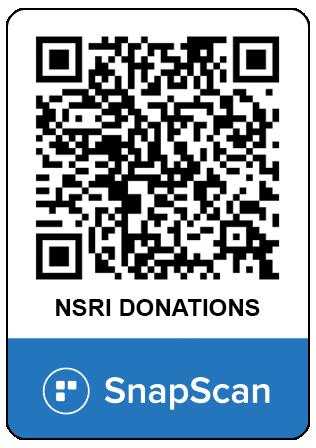
Scan this QR code or visit the link below to pay using SnapScan. https://pos.snapscan.io/qr/ STB4C055
Please use your cellphone number as base/project reference so we can acknowledge your donation.

Scan this QR code or visit the link below to pay using Zapper. https://www.zapper.com/ url/KU1oB
Please use your cellphone number as base/project reference so we can acknowledge your donation.
